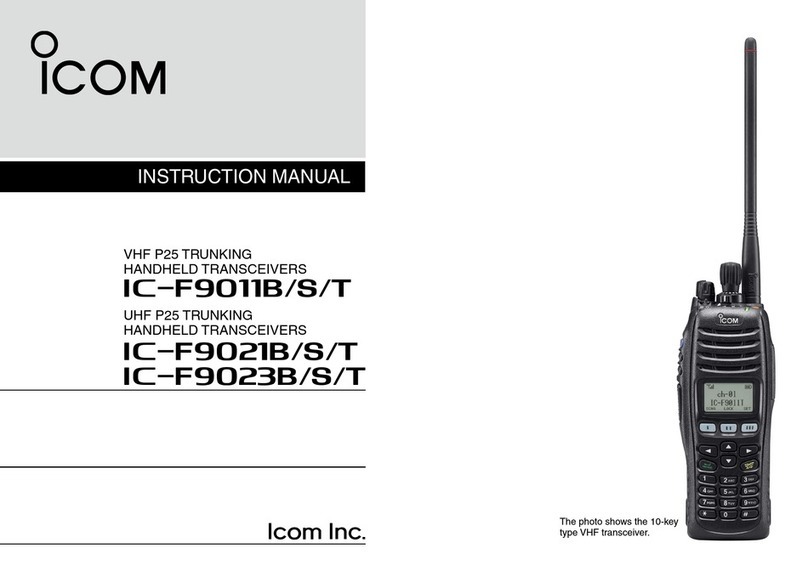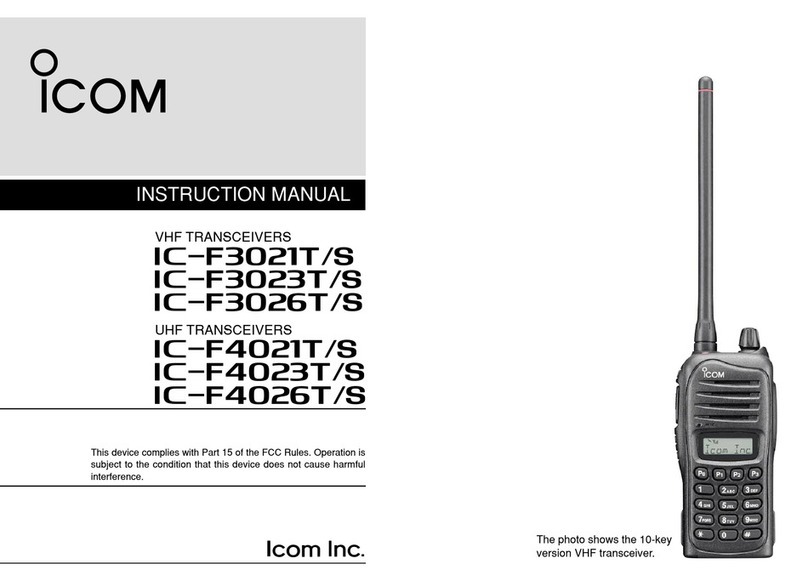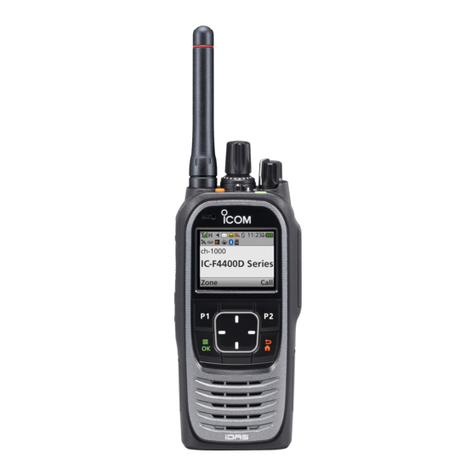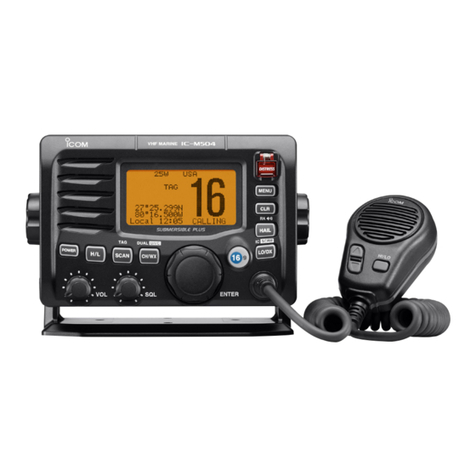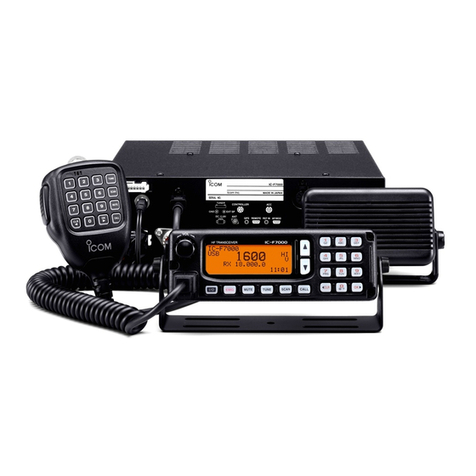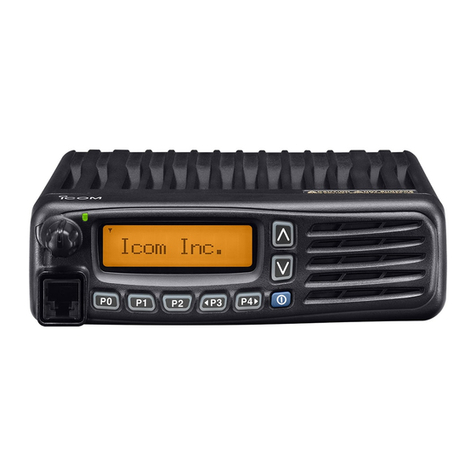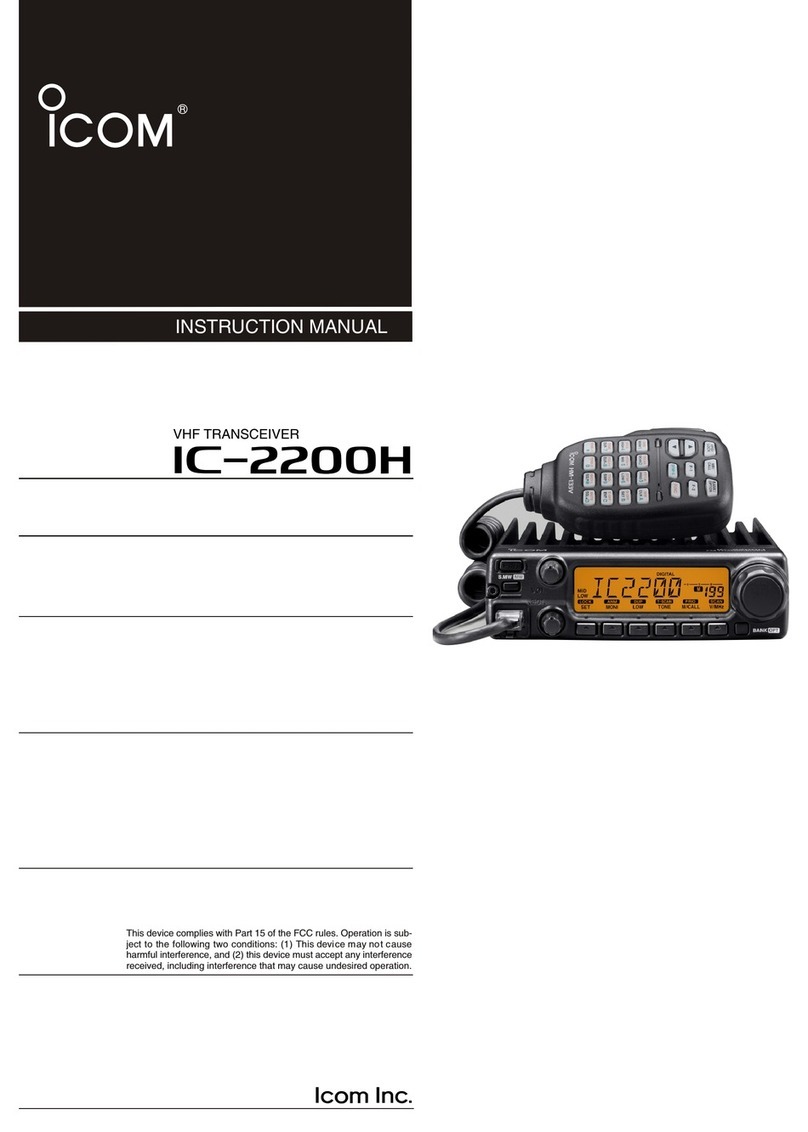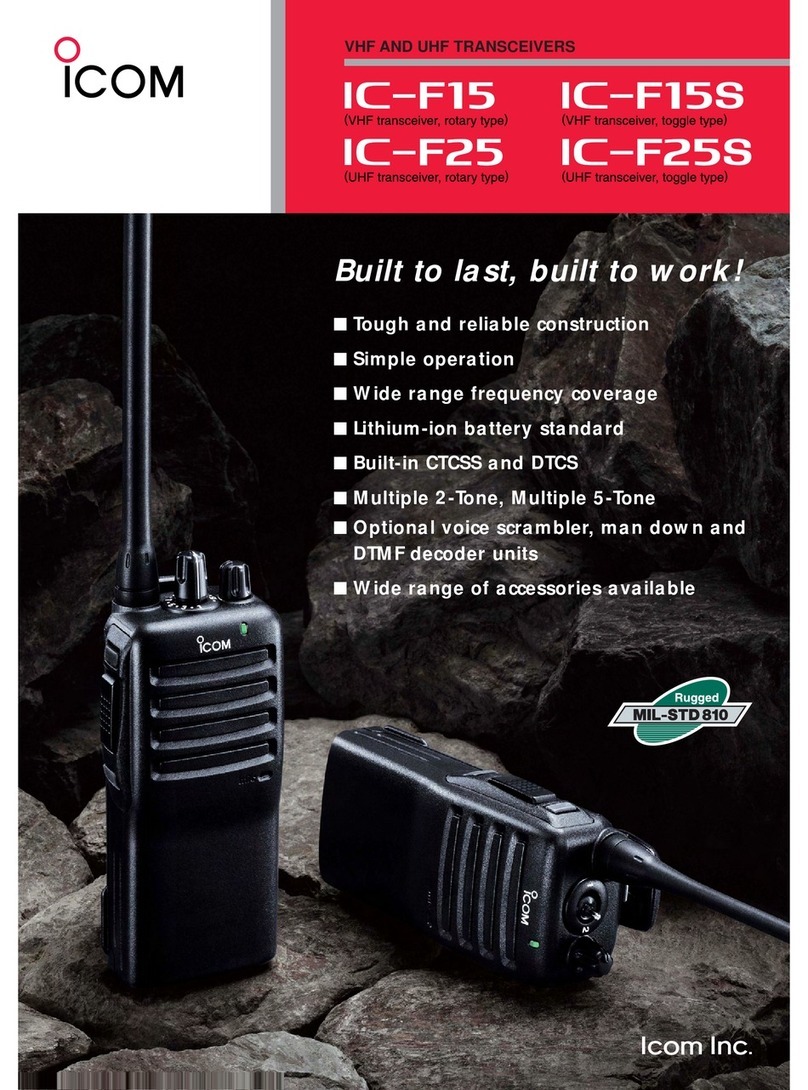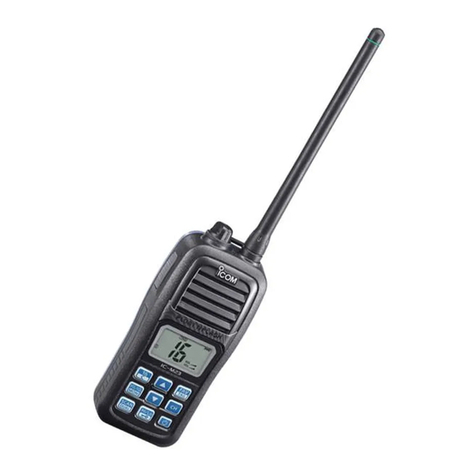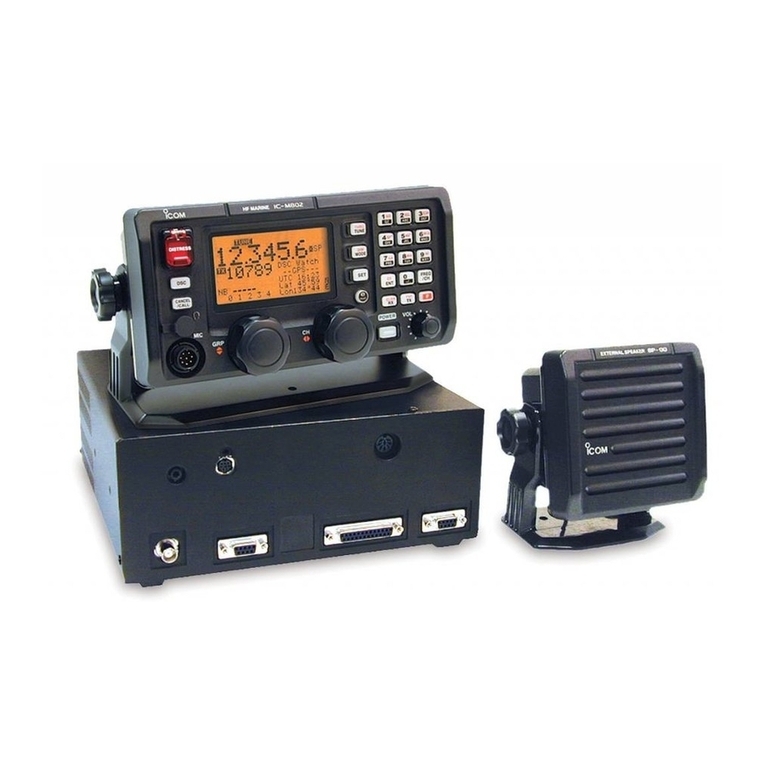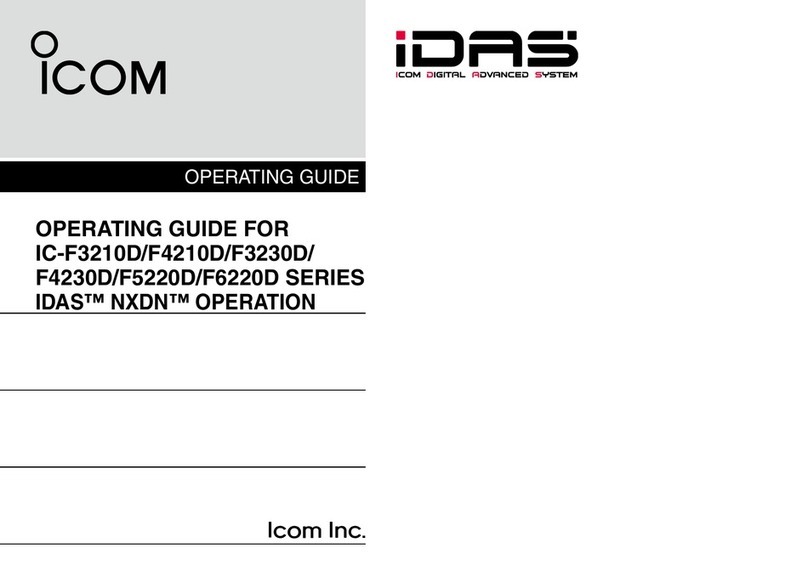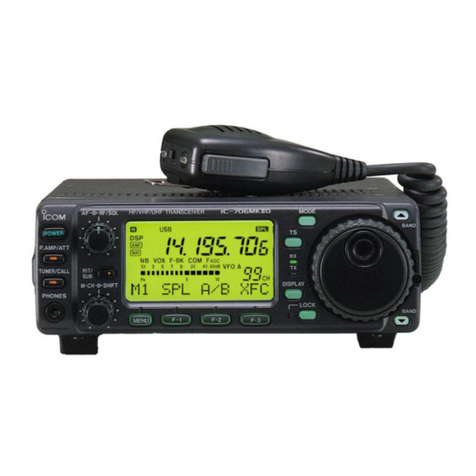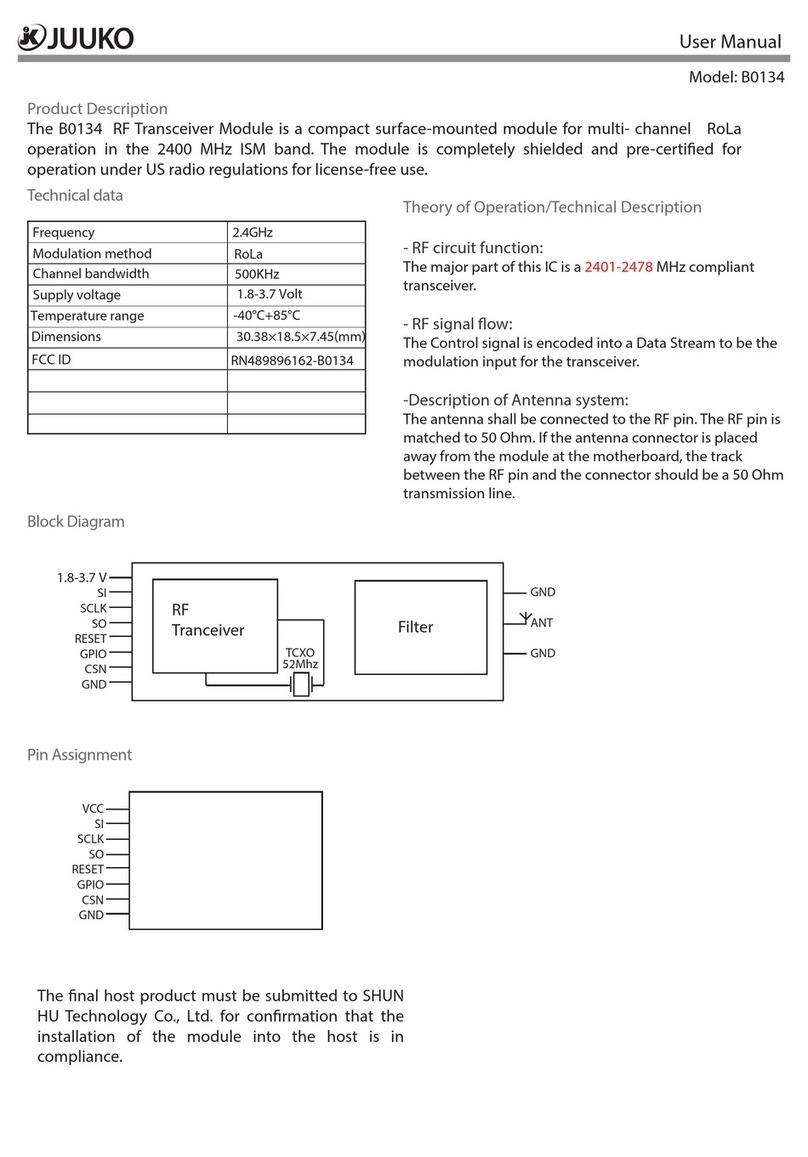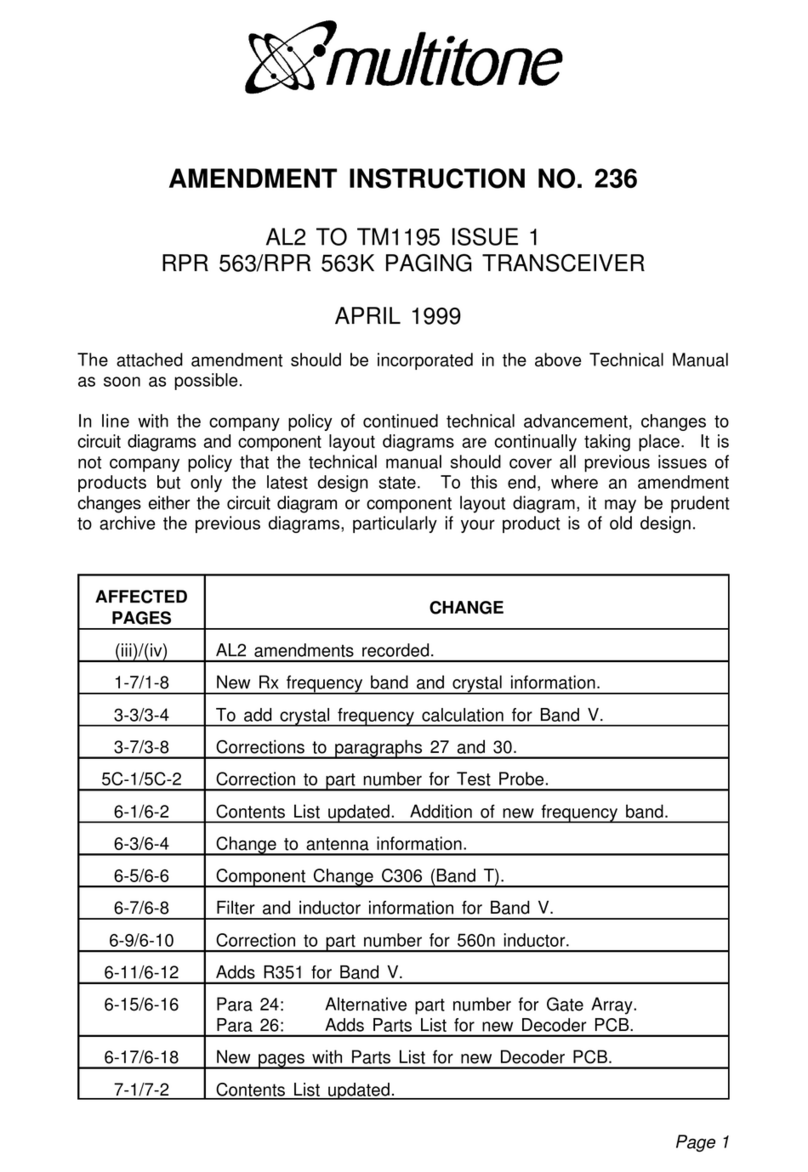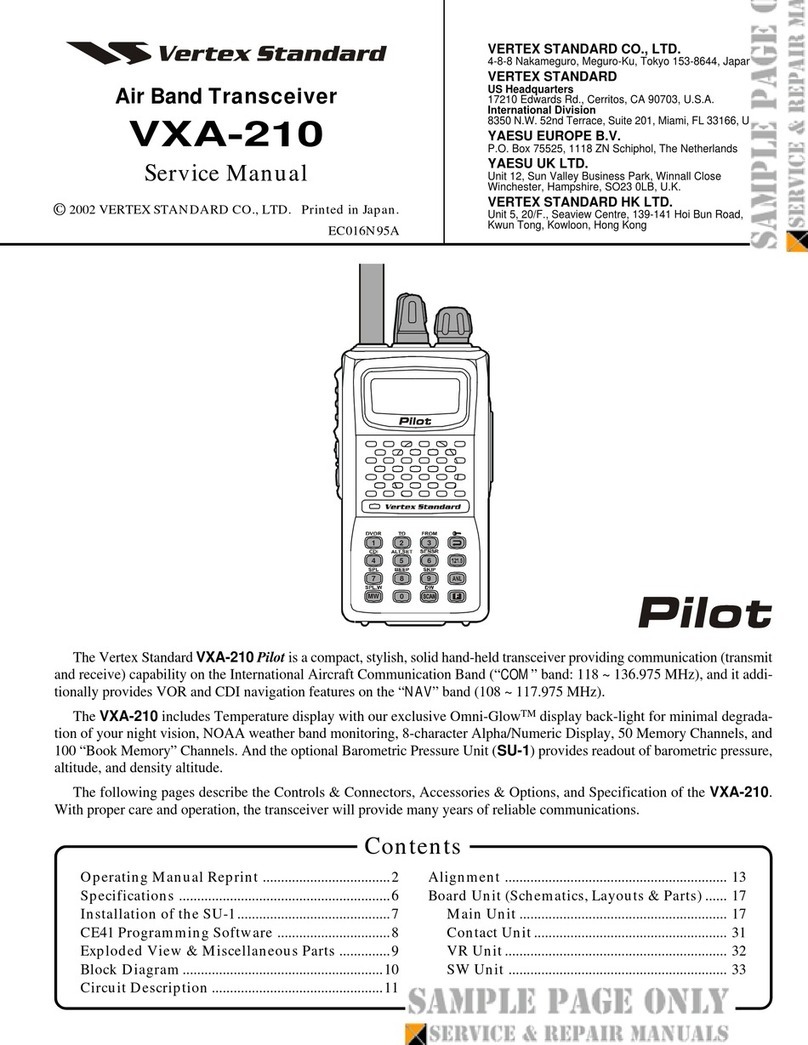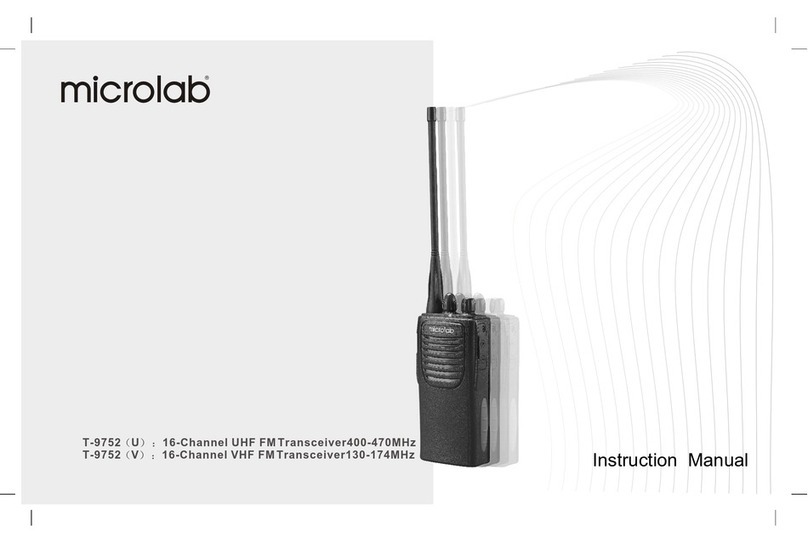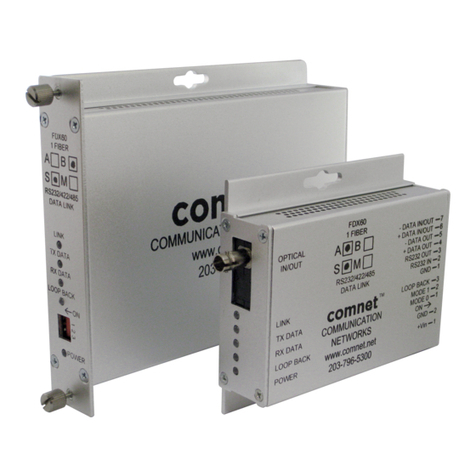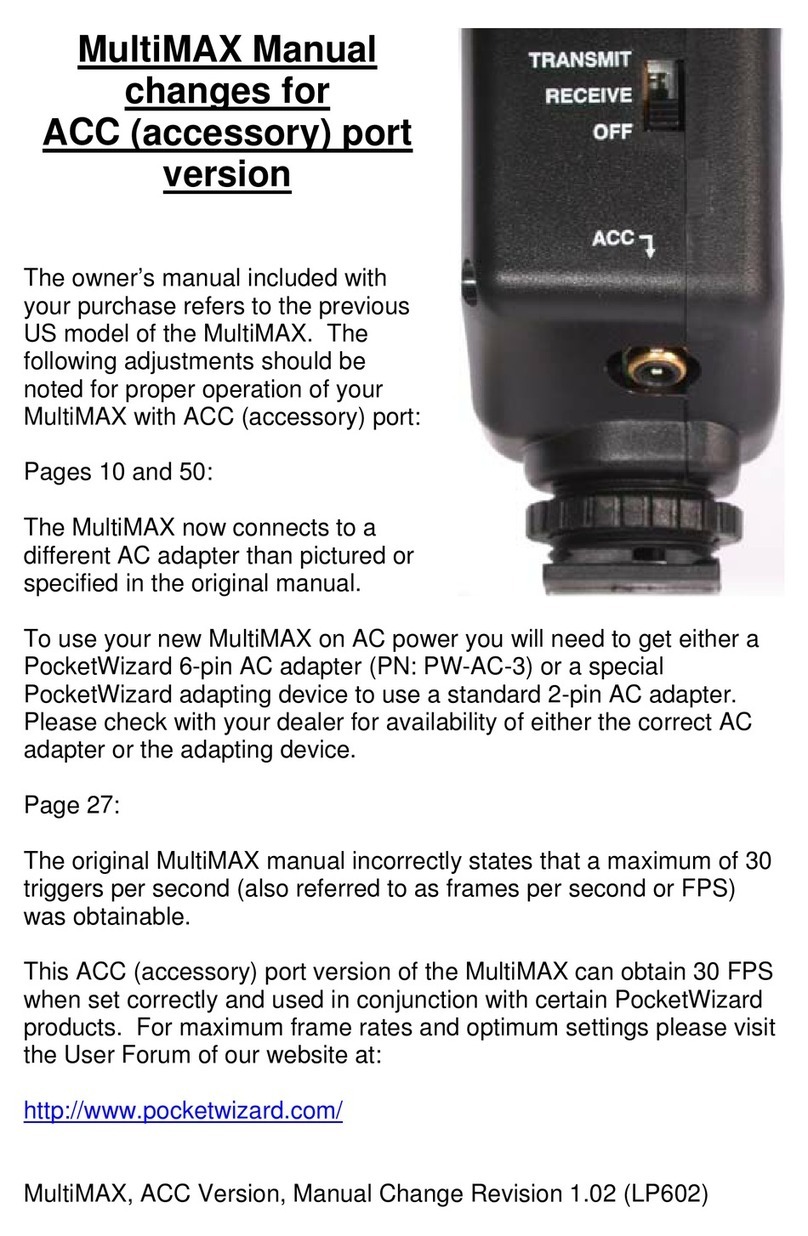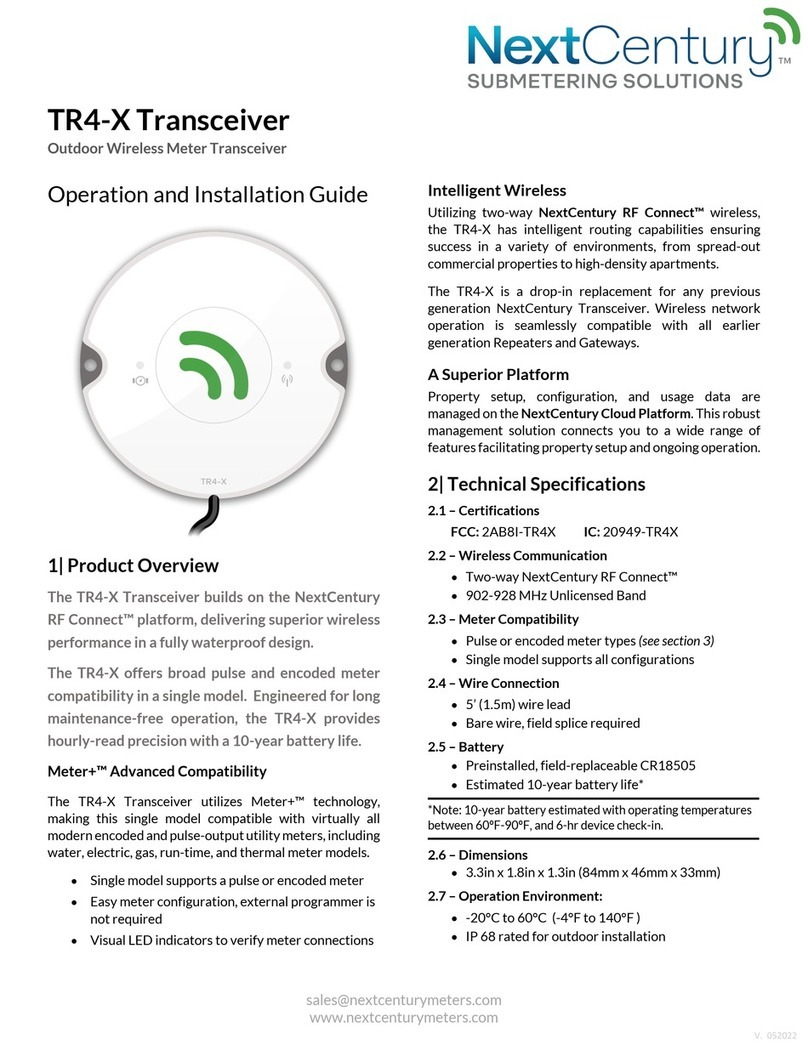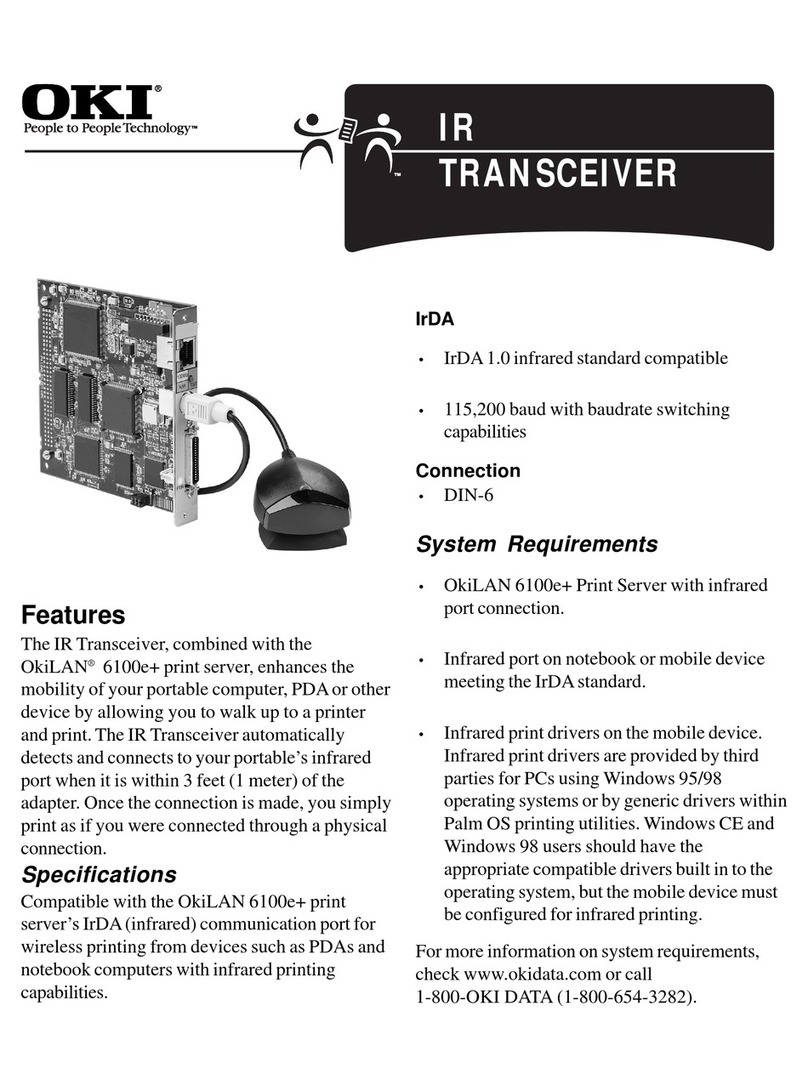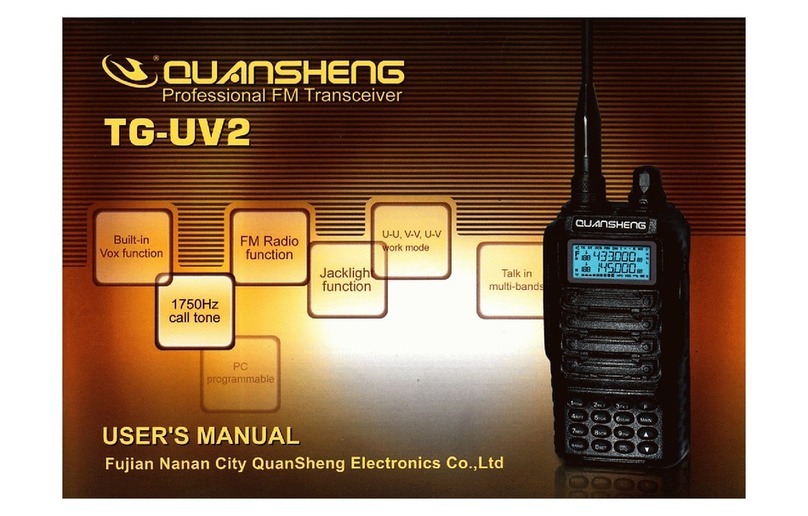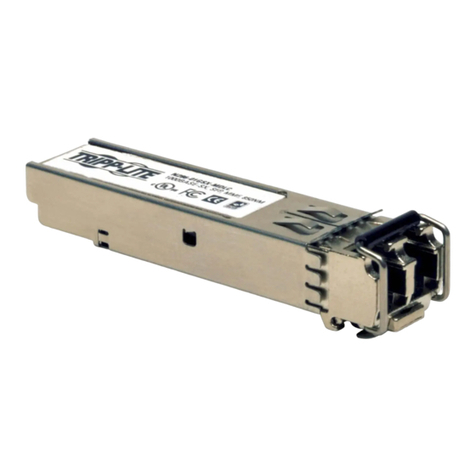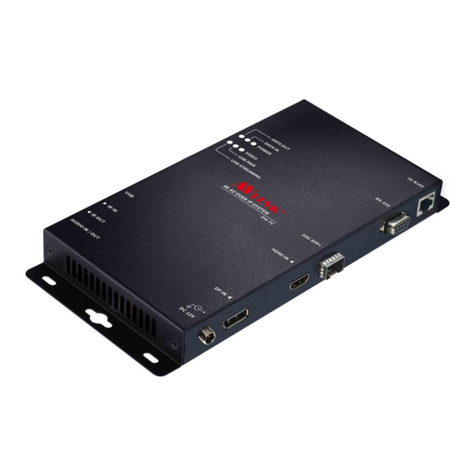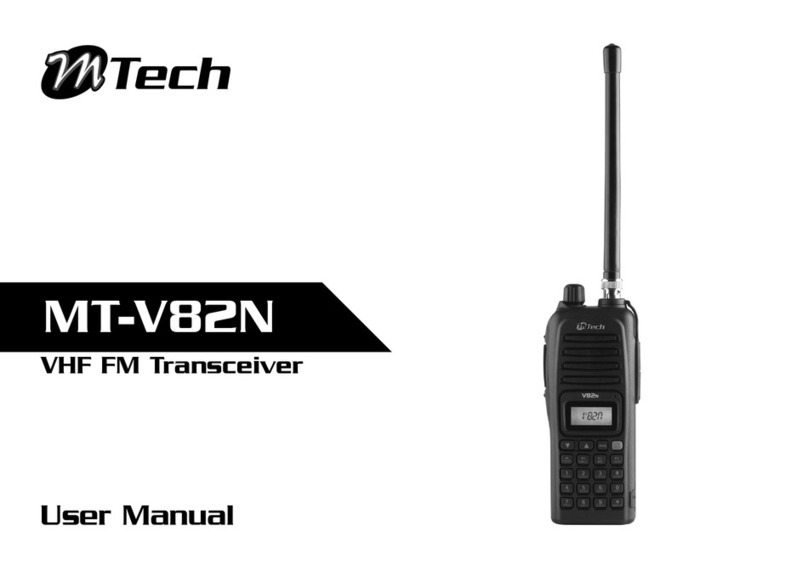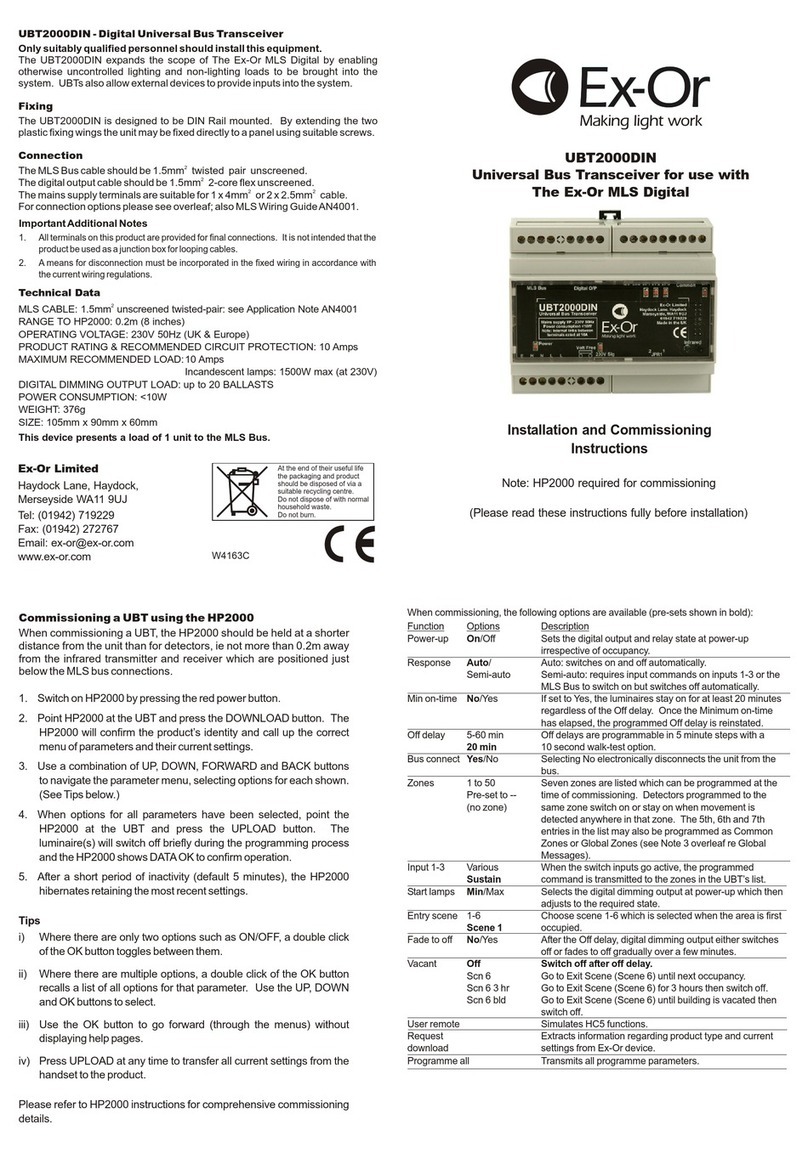Icom IC-E2820 User manual

S-14326XZ-C1
Apr. 2007
DUAL BAND FM TRANSCEVER
iC-e2820

This service manual describes the latest service information
for the IC-E2820 DUAL BAND FM TRANSCEVER at the
time of publication.
NEVER connect the transceiver to an AC outlet or to a DC
power supply that uses more than 15 V. This will ruin the
transceiver.
DO NOT expose the transceiver to rain, snow or any liquids.
DO NOT reverse the polarities of the power supply when
connecting the transceiver.
DO NOT apply an RF signal of more than 20 dBm (100 mW) to
the antenna connectors. This could damage the transceiver’
s front end.
To upgrade quality, any electrical or mechanical parts and
internal circuits are subject to change without notice or
obligation.
MODEL VERSION
IC-E2820 EUR-01
EUR-02
Be sure to include the following four points when ordering
replacement parts:
1. 10-digit order numbers
2. Component part number and name
3. Equipment model name and unit name
4. Quantity required
<SAMPLE ORDER>
1110003491 S.IC TA31136FNG IC-E2820 MAIN UNIT 5 pieces
8820001210 Screw 2438 screw IC-E2820 Top cover 10 pieces
Addresses are provided on the inside back cover for your
convenience.
Icom, Icom Inc. and logo are registered trademarks of Icom Incorporated (Japan) in the United States, the United
Kingdom, Germany, France, Spain, Russia and/or other countries.
ORDERING PARTS
1. Make sure a problem is internal before disassembling
the transceiver.
2. DO NOT open the transceiver until the transceiver is
disconnected from its power source.
3. DO NOT force any of the variable components. Turn
them slowly and smoothly.
4. DO NOT short any circuits or electronic parts. An
insulated tuning tool MUST be used for all adjustments.
5. DO NOT keep power ON for a long time when the
transceiver is defective.
6. DO NOT transmit power into a signal generator or a
sweep generator.
7. ALWAYS connect a 50 dB to 60 dB attenuator between
the transceiver and a Modulation Analyzer or spectrum
analyzer when using such test equipment.
8. READ the instructions of test equipment thoroughly
before connecting equipment to the transceiver.
REPAIR NOTES
INTRODUCTION CAUTION

CONTENTS
SECTION 1 SPECIFICATIONS
SECTION 2 INSIDE VIEWS
SECTION 3 DISASSEMBLY INSTRUCTIONS
SECTION 4 CIRCUIT DESCRIPITON
4-1 RECEIVER CIRCUITS............................................................................................................... 4-1
4-2 TRANSMITTER CIRCUITS ....................................................................................................... 4-4
4-3 FREQUENCY SYNTHESIZER .................................................................................................. 4-6
4-4 POWER SUPPLY CIRCUITS..................................................................................................... 4-8
4-5 PORT ALLOCATIONS ............................................................................................................... 4-9
SECTION 5 ADJUSTMENT PROCEDURES
5-1 PREPARATION .......................................................................................................................... 5-1
5-2 FREQUENCY ADJUSTMENT ................................................................................................... 5-2
5-3 TRANSMIT ADJUSTMENT ....................................................................................................... 5-3
5-4 RECEIVE ADJUSTMENT .......................................................................................................... 5-4
SECTION 6 PARTS LIST
SECTION 7 MECHANICAL PARTS
SECTION 8 BOARD LAYOUTS
SECTION 9 BLOCK DIAGRAM
SECTION 10 VOLTAGE DIAGRAM
SECTION 11 HM-133
SECTION 12 UT-123 (Optional product)

1 - 1
SECTION 1 SPECIFICATIONS
LARENEG
•)zHM
:t
inu
(
:egarevoc
ycneuqerF
*1*;.ylnoeg
narzHM
641–44
1:
deetna
rauG 2*;zHM044–0
34
:deetn
arauG 3d
e
e
tn
ar
a
ugtoN
T•
MA,
M
F
:
noissimefo
epy )
y
lno
e
viec
e
R( ,
V
D)
de
riu
qe
rs
i
321
-
TU
l
ano
it
po(
•)sl
la
c
2dna
se
gde
na
c
s
02.lcn
i
(225:slennahc
y
ro
me
m
fo
re
bmu
N
•z
H
k
05
,0
3,5
2,
02,
5
1,5.
21,
0
1,5
2.6
,5
:
n
oi
tu
l
o
s
e
ry
c
ne
u
qer
F
•C°06
+otC°01–
:egna
re
r
u
ta
rep
metgn
i
tar
ep
O
F
•mpp
5
.2±:
y
til
i
ba
t
sycneuqer )C°06+otC°01–(
•%51±
CD
V8
.31
:tne
me
ri
u
qerylpp
u
s
re
wo
P
•n
iard
tnerru
C).
x
o
r
p
p
a
:
CDV
8
.
3
1
ta( :
TA
31
W
05
tatimsnar
A
2
.
1
ybdnat
se
vie
c
eR
)eviecersuoe
n
atlumis( A8.1oidua.xam
•932-
O
S:ro
t
cenno
c
annet
nA 05
(Ω)×2)yti
s
re
v
iD
d
n
a
xR
/
xT
(
•sno
isnemi
D)de
d
ulcn
i
ton
.jor
p
(:
)W
(051tinU
nia
M×)H(04 ×mm
)D(7
.781
)
W
(051
re
l
lo
r
tno
c
e
to
meR ×)H
(
85 ×m
m
)D(5
.13
W•thgie ).xorppa( :
g
k5
.1
tinunia
M
g
012
re
l
lo
r
tno
c
e
to
meR )
elb
ac
no
it
arap
e
s
.
l
c
ni
(
eVd
na
Bt
h
giRdnaBtfeLnoisr
*599.945–811:x
R,1 *2
*
59
9.
3
7
1–811:xR 1*59
9
.9
45–
5
7
3, 2,
1ep
or
u
E044–034,641–441:xT 99
.999–018
*3
044–034
,641–441:xT
2
eporuE 044
–034
,641–441:xR/xT
M
R
E
T
T
IMSNART
•noi
ta
ludo
m
y
cneuqe
rf
e
cnat
cae
r
elbai
ra
V:me
t
s
y
s
noi
ta
ludo
M
•W5
/51
/05
:
re
wop
tup
tu
O)
.
x
or
p
p
a
(
•
z
H
k
0
.5
±
:
no
i
tai
v
ed
y
cn
euqe
r
f
.
xa
M)ediw(
z
Hk5.
2± )
w
orr
a
n(
•Bd
06
–naht
s
seL:
sno
i
s
si
me
suoi
rupS
•
ra
ludom
nip
-8
:ro
t
cenn
o
c
enohpo
r
c
iM 0
06
(Ω)
M
REV
I
ECER
•en
ydo
re
teh
repu
sno
i
s
re
vno
c
-elbuoD:
me
t
s
y
sevie
ce
R
•:
seicneuqer
f
e
ta
ide
m
re
tn
I
z
H
k
054
:dn2
,
z
HM
58
.83
:
t
s1
dnab
t
feL
zH
k
054
:dn2
,zHM53.64
:
ts1dnabthg
i
R
•yt
ivit
i
s
n
eS )
y
lno
sd
n
abr
u
etam
a
(:
M
F)
DANISBd
2
1( Vµ
8
1.
0
nahts
s
eL
VD )
%
1
R
EB( Vµ53.0na
ht
sseL
)
deri
u
qer
s
i
3
21-TUlan
o
it
p
o(
•yt
iv
it
i
s
neshcle
u
qS †)
d
l
o
hs
e
r
h
t
(:
Vµ31.0
nah
ts
seL
•yt
ivitcele
S†:)lacip
y
t
(
Bd6/zH
k01
nahteroMediW
Bd
06
/
zH
k03naht
s
seL
Bd6/z
H
k6nah
t
ero
M
worraN
Bd
06
/
zH
k02n
aht
s
seL
VD )
d
e
r
iu
q
ersi321-TUl
a
noit
p
o( Bd05naht
e
roM
•noitcejeregamidnasuoirupS †Bd06naht
e
roM
:
.dnab
t
feln
o
FH
U
r
of
Bd
55n
a
h
te
r
o
M
*
•
rewoptuptuoFA
†
)CDV8.31ta(
:
W
4.2
n
aht
ero
Mnahtiw
noit
r
otsi
d
%0
1
ta
8Ωd
a
ol
•8
/
m
m)d
(5
.3
ro
t
cudnoc-3:srotcennocrekaeps.txE Ω
†.
y
ln
o
s
e
g
n
a
r
z
H
M
0
4
4
–
0
34
d
n
a
z
H
M
6
41–4
41
dee
t
nara
u
G
i
cepsdet
a
ts
l
lA .
no
it
agi
lbo
ro
e
c
i
tontuoh
t
iwegnahcot
t
cejbus
e
rasnoitac
M

2 - 1
SECTION 2 INSIDE VIEWS
D/A converter
(IC8: M62364FP)
Level converter
(IC46: MAX3221IPWR)
1st IF Mixer for VHF bands
(IC19: SPM5001)
LO divider
(79.150−121.150 MHz)
• BOTTOM VIEW
• TOP VIEW
IF IC (Right band)
(IC18: TA31136FNG)
IF IC (Left band RX)
(IC15: TA31136FNG)
Reference frequency oscillator
(Left band)
Reference frequency oscillator
(Right band)
VHF PA module
(IC3: S-AV32)
UHF PA module
(IC2: S-AU82L)
CPU
(IC25: HD64F2506RFC26DV)
EEPROM
(IC22: 24LC512)
DTMF decoder
(IC56: BU8872FS)
AF power amplifier
(IC38: LA4445)
D/A converter
(IC1: M62364FP)
AF switch
(IC30: CD4066BPWR)
AF switch
(IC31: CD4066BPWR)
AF filter
(IC48: LM2902PWR)
D/A converter
(IC54: M62364FP)
Electric volume
(IC33: SM6451B)
Frequency synthesizer
(Right band)
Frequency synthesizer
(Left band)
LO filter
(763.650−953.640 MHz)
1st IF Mixer for UHF bands
(IC20: SPM5001)

3 - 1
SECTION 3 DISASSEMBLY INSTRUCTION
1. Removing the top cover
qUnscrew 10 screws, then remove the top cover.
3. Removing the MAIN UNIT
qUnscrew 11 screws from the MAIN UNIT.
2. Removing the bottom cover
qUnscrew 7 screws, then remove the bottom cover.
10 screws
Top cover
wDisconnect the speaker cable.
Speaker cable
Bottom cover
7 screws
wDisconnect the cooling fan cable, and unsolder 6 points at
the antenna connectors (grey colored).
6 unsoldering points
Cooling fan cable
MAIN UNIT
eRemove the MAIN UNIT in the direction of the arrow.

4 - 1
SECTION 4 CIRCUIT DESCRIPTION
4-1 RECEIVER CIRCUITS
RF CIRCUITS
<Left band>
• 118−174 MHz
The received signals from the antenna connector ANT-1
(J1) are passed through two LPFs (L101, 104, 108, C342,
346; L88, 92, 96, C318, 326, 330), then applied to the RF
amplifier (Q37) via TX/RX switch (D75). The amplified signals
are passed through the RX switch (RL2), attenuator (D68)
and tuned BPF (D55, 66), before being applied to another
RF amplifier (Q33). The amplified signals are applied to the
1st mixer (IC19) via the another tuned BPF (D41, 44) and
RX switch (D38).
While the diversity operation is activated, the received
signals are also input from ANT-2 (J2). The received signals
are passed through two LPFs (L103, 106, 109, C344, 348;
L90, 93, 98, C319, 327, 348), antenna switch (D65, 72) and
limitter (D64, 67), then applied to the RF amplifier (Q39).
The amplified signals are applied to the RX switch (RL2),
and gone through the same process as the received signals
from ANT-1 (J1).
• 174−260 MHz
The received signals from the antenna connector (J1) are
passed through two RX switches (RL3 and D56) and the
tuned BPF (D51), then applied to the RF amplifier (Q34).
The amplified signals are passed through the BPF (D45),
attenuator (R139, 144, 147) and RX switch (D36) before
being applied to the 1st mixer (IC19).
• 260−375 MHz
The received signals from the antenna connector (J1) are
passed through two RX switches (RL3 and D57) and the
tuned BPF (D50), then applied to the RF amplifier (Q35).
The amplified signals are passed through the BPF (D465),
attenuator (R142, 143, 150) and RX switch (D37) before
being applied to the 1st mixer (IC19).
• 375−550 MHz
The received signals from the antenna connector (J1) are
passed through the LPF (L101, 104, 108, C342, 346) and
HPF (L77, 80, C296, 297, 303, 308), then applied to the
RF amplifier (Q28) via TX/RX switch (D53, 61, 62). The
amplified signals are passed through the RX switch (RL1),
attenuator (D28) and tuned BPF (D19, 21, 24, 27), before
being applied to another RF amplifier (Q20). The amplified
signals are applied to the 1st mixer (IC19) via the another
tuned BPF (D11, 13, 15, 17) and RX switch (D8).
While the diversity operation is activated, the received
signals are also input from antenna connector ANT-2 (J2).
The received signals are passed through the LPF (L103,
106, 109, C344, 348), HPF (L95, 99, C329, 333, 338),
antenna switch (D69, 73, 74) and limitter (D63, 66), then
applied to the RF amplifier (Q29).
The amplified signals are applied to the RX switch (RL1),
and gone through the same process as the received signals
from ANT-1 (J1).
RF
AMP
RX
SW
LPF
HPF
ATT
RX
SW
ATT
BPF ATT
RX
SW
HPF
RF
AMP ATT
RF
AMP
BPF
ATT
RF
AMP
LPF
ANT
SW
BPF
RF
AMP
BPF
RF
AMP
RX
SW
LPF
RF
AMP
BPF
RF
AMP
LPF
BPF
ATT
RF
AMP
HPF
BPF
BPF
RX
SW
BPF
BPF RX
SW
BPF
RF
AMP
RX
SW
RX
SW
RF
AMP
TX/RX
SW
RX
SW
HPF
ATT
RX
SW
ANTENNA
ATT
RX
SW
RX
SW
RX
SW
ANT
SW
BPF
ANTENNA
RF
AMP
D62
TX/RX
SW
D59
D77
D75
D61
D53
LIMIT
D10,
D32
D8
D64,D67
D11
D58
RL1
D14,
D76
Q29
D60
Q28
D38
D16
D70
,D13,
D65,D71,D72
D23,
Q38
D28
D19,
D55,
Q37
D24,
RL2
Q30
D17
D63,D66
D18,
Q20
D30
Q32
D48,D49
D15,
D12,
LIMIT
375−550 MHz
D40,
D78,
LIMIT
375−550 MHz
D69,D73,D74
D44
D35
D26
118−174 MHz
D7
118−174 MHz
Left band
R
ight band
D41,
D27
D68
Q39
D43
LIMIT
D20,
D54,
Q33
810−1000 MHz
D37
D51
Q18
D50
D46
D45
Q35
D80
D22
D9
Q40
D36
Q23
Q34
174−260 MHz
260−375 MHz
RL3
D57
D56
D79
Q19
D21,
• RF CIRCUITS

4 - 2
1ST IF CIRCUITS
RX signals from the RF circuits are converted into the 38.85
MHz 1st IF signal by being mixed with LO signals from the
left band VCO (Q111, D145−147).
The converted IF signal from the 1st mixer is passed through
the IF filter (FI5) to be filtered. The filtered IF signal is applied
to the 1st IF amplifier (Q66) via the limiter (D88). The amplified
1st IF signal is applied to the IF IC (IC15, pin 16)
2ND IF AND DEMODULATOR CIRCUITS (Fig. 2)
IC15 is an IF IC which contains 2nd mixer, limiter amplifier,
noise amplifier, quadrature detector and RSSI circuit, etc. in
its package.
The 1st IF signal from the 1st IF amplifier (Q66) is converted
into the 450 kHz 2nd IF signal by being mixed with tripled
reference frequency signal (38.4 MHz) from the PLL IC (IC41)
via the tripler (Q105). The converted 2nd IF signal is output
from pin 3, and passed through the ceramic filter (FI1 for
narrow mode, FI2 for wide mode) to remove sideband noise,
then applied to the IF IC from pin 5 again.
• FM DEMODULATOR
The filtered 2nd IF signal from pin 5 is amplified at the limiter
amplifier, and FM-demodulated at the quadrature detector
circuit. The demodulated AF signals are output from pin 9
and routed to the AF circuits via two AF switches (IC11 and
IC13).
• AM DEMODULATOR CIRCUITS
In the AM mode, the 2nd IF signal from the FI2 is applied to
the AM-demodulator circuit (Q55, Q57). The demodulated
AF signals are routed to the AF circuits via two AF switches
(IC11 and IC13).
SQUELCH CIRCUITS
• NOISE SQUELCH
A portion of FM-demodulated AF signals from the IF IC
(IC15, pin 9) are level-adjusted by D/A converter (IC8), and
passed throuhgh the noise fltier (IC15 and some R and C) to
be filtered noise components (30 kHz and above signals) in
the AF signals. The filtered noise components aree detected
in the IC15 and output from pin 13, then applied to the CPU
(IC25, pin 100) as “L_SQL” signal.
Then the CPU outputs “L_AF_MUTE” signal from pin 82 to the
speaker mute switch (Q102), according to the “L_SQL” signal
level. Thus the AF line is connected to the GND to turn the AF
output OFF.
• CTCSS/DTCS
CTCSS/DTCS signals in the demodulated AF signals from
the AF switch (IC13) are passed through the tone filter (Q41)
. The filtered CTCSS/DTCS signals are applied to the CPU
IC25, pin 70) as “L_DTCSIN” signal. The CPU (IC25) com-
pares the applied signal and the set CTCSS/DTCS, then out-
puts control signal as same as “NOISE SQUELCH.”
• DTMF
DTMF signals in the demodulated AF signals from the AF
switch (IC13) are passed through two AF switches (IC57
and IC58), then applied to the DTMF decoder (IC56) to be
decoded.
AF CIRCUITS
The AM/FM-demodulated AF signals from the AF switch
(IC11) are passed through the AF filter (Q47). The filtered
AF signals are applied to the electric volume (IC33) to be
adjusted its level. The level-adjusted AF signals are applied
to the dual AF power amplifiier (IC38) to obtain AF output
power level, then applied to the internal (CHASSIS; SP1)
or an external speaker via external speaker jack (J7).
If an external speaker is connected to the J8, the level-
adjusted AF signals from the electric volume (IC33) are
applied to the connected speaker.
• 2ND IF AND DEMODULATOR CIRCUITS (LEFT BAND)
R321
R328
C428
X2
R315
R317
C419
R306
R308
R310
DEMODULATOR
CIRCUITS
(Left
band)
C407
C425
R327
C423
C417
R335
C422
R324
R307
Q57
1
2
34
5
6
C427
1
2
3
4
5
6
7
8
9
10
11
12
13
14
15
16
R311
C435
C426
C404
Q55
1
2
34
5
6
R341
R346
R314
C429
C416 R332
R319
C418
R884
L_RSSI
L_SQL
OSCIN
OSCOUT
MIXOUT
VCC
IFIN
DEC
FILOUT
FILIN
AFOUT
QUAD
IFOUT
RSSI
N-DET
N-REC
GND
MIXIN
AM-demodulated AF signals
to the AF circuits
L_R5
FM-demodulatedAF signals
from the D/A converter (IC8)
1st IF signal from
the 1st IF amplifier(Q66)
38.4 MHz 2nd LO signal
from the PLL IC (IC41)
FM-demodulated AF signals
to the AF circuits
NOISE FILTER
AM DEMODULATOR CIRCUITS
R334
FI1
I O
D83
C932
D82
C933
D84 C437
D85
C931
R316
C930
FI2
I O
2nd IF FILTERS
QUADRATURE DETECTOR
IF IC (IC15)
AGC voltage to the 1st IF amplifier (Q66)

4 - 3
R366
C928
FI3
C926
R885
R352
C460
R414
R400
C491
C470
R351 AM DEMODULATOR CIRCUITS
• DEMODULATOR CIRCUITS (Right band)
NOISE FILTER
X3
180K
R376
C454
R397
C476
R375
AGC voltage to the 1st IF amplifier (Q75)
R415
IF IC (IC18)
1
OSCIN 2
OSCOUT 3
MIXOUT 4
VCC 5
IFIN 6
DEC 7
FILOUT 8
FILIN
9AFOUT
10 QUAD
11 IFOUT
12 RSSI
13 N-DET
14 N-REC
15 GND
16 MIXIN
R383
C487
D95
1st IF signal from
the 1st IF amplifier(Q75)
45.9 MHz 2nd LO signal
from the PLL IC (IC14)
C478
C495
C450
R372
C480
C475
D93
R374
R374
C486
D96
R359
C927
R402
C458
0.01
C471
C477
R389
R388
D94 FI4
Q63
1
2
34
5
6
R385
C929
R358
Q67
1
2
34
5
6
R_R5
R_R5
R_R5
2nd IF FILTERS
R_RSSI
R_SQL
QUADRATURE DETECTOR
AM-demodulated AF signals
to the AF circuits
FM-demodulatedAF signals
from the D/A converter (IC8)
FM-demodulated AF signals
to the AF circuits
RF CIRCUITS
<Right band>
• 118−174 MHz
The received signals from the antenna connector ANT-1
(J1) are passed through two LPFs (L101, 104, 108, C342,
346; L88, 92, 96, C318, 326, 330), then applied to the
RF amplifier (Q37) via TX/RX switch (D59). The amplified
signals are passed through the attenuator (D70) and tuned
BPF (D54, 58), before being applied to another RF amplifier
(Q32). The amplified signals are applied to the 1st mixer
(IC20) via the another tuned BPF (D40, 43) and RX switch
(D35).
• 375−550 MHz
The received signals from the antenna connector (J1) are
passed through the LPF (L101, 104, 108, C342, 346) and
HPF (L77, 80, C296, 297, 303, 308), then applied to the
RF amplifier (Q28) via TX/RX switch (D53, 61, 62). The
amplified signals are passed through the attenuator (D30)
and tuned BPF (D18, 20, 23, 26), before being applied
to another RF amplifier (Q19). The amplified signals are
applied to the 1st mixer (IC20) via the another tuned BPF
(D10, 12, 14, 16) and RX switch (D7).
• 810−1000 MHz
The received signals from the ANT-1 (J1) are passed
through the HPF (L102, 105, 107, 110, C337, 339, 340,
343, 347, 349) and RX switch (D22), then applied to the RF
amplifier (Q23). The amplified signals are passed through
the attenuator (R39, 40, 51), and applied to the another RF
amplifier (Q18) to be amplified again. The amplified signals
are then passed through another attenuator (R14) and RX
switch (D9) before being applied to the 1st mixer (IC20).
1ST IF CIRCUITS
RX signals from the RF circuits are converted into the 46.35
MHz 1st IF signal by being mixed with LO signals from the
right band VCO (Q72, D89, 90; Q73, D87, 91, 92).
The converted IF signal from the 1st mixer (IC20) is passed
through the IF filter (IF6) to be filtered. The filtered IF signal is
applied to the 1st IF amplifier (Q75) via the limiter (D100). The
amplified 1st IF signal is applied to the IF IC (IC18, pin 16)
2ND IF AND DEMODULATOR CIRCUITS
IC15 is an IF IC which contains 2nd mixer, limiter amplifier,
noise amplifier, quadrature detector and RSSI circuit, etc. in
its package.
The 1st IF signal from the 1st IF amplifier (Q75) is converted
into the 450 kHz 2nd IF signal by being mixed with tripled
reference frequency signal (45.9 MHz) from the PLL IC (IC14)
via the tripler (Q52). The converted 2nd IF signal is output
from pin 3, and passed through the ceramic filter (FI3 for
narrow mode, FI4 for wide mode) to remove sideband noise,
then applied to the IF IC from pin 5 again.
• FM DEMODULATOR
The filtered 2nd IF signal from pin 5 is amplified at the limiter
amplifier, and FM-demodulated at the quadrature detector
circuit (X3). The demodulated AF signals are output from pin
9 and routed to the AF circuits via two AF switches (IC12
and IC16).
• AM DEMODULATOR CIRCUITS
In the AM mode, the 2nd IF signal from the FI3 is applied to
the AM-demodulator circuit (Q63, Q67). The demodulated
AF signals are routed to the AF circuits via two AF switches
(IC12 and IC16).

4 - 4
4-2 TRANSMITTER CIRCUITS
MICROPHONE AMPLIFIER CIRCUITS
The audio signals from the microphone (MIC signals) are
applied to the microphone amplifier (IC28) via J2 and HPF
(Q87). The amplified MIC signals are passed through the
microphone gain switch (Q88) and MIC mute switch (IC30),
then passed through or by-passed ALC amplifier (IC32) via
AF switches (IC29 and IC52).
The MIC signals from the AF switch (IC52) are passed
though the HPF (IC48), LPF (IC48) and AF switch (IC51),
and then applied to the AF amplifier (IC48). The amplified
MIC signals are applied to the D/A converter (IC8) for level
(deviation) adjustment. The level adjusted MIC signals are
applied to the VCO as the modulation signals via modulation
signal selector.
<OPERATION ON THE LEFT BAND>
The modulation signals are applied to the variable capacitor
D147 of the left band VCO (Q111, D145–147) via the
modulation selector (IC9) and modulation mute switch
(Q109), and modulated. The modulated VCO output are
amplified by the buffer (Q113) and LO amplifier (IC44), and
applied to the transmit amplifiers as the TX signal, via the LO
switches (D155, 157), LPF(L157, C818, 820) and attenuator
(R33, 37, 46).
TRANSMIT POWER AMPLIFIERS
TX signal from the attenuator (R33, 37, 46) is amplified by
pre-drive (Q25) and drive (Q27) amplifiers to obtain RF level
for power module (IC3). The amplified TX signal is applied
to the power amplifier which is a VHF band PA module
composed by two power MOS-FETs. The power-amplified
TX signal is passed through the LPF, power detector,
antenna switch (D59) and LPF, before being applied to the
antenna connector (CHASSIS; J1).
APC CIRCUITS
A portion of the TX signal from IC3 is rectified at the power
detector (D39, D47), and converted into the DC voltage
which is in proportion to the RF power, and applied to the
operational amplifier (IC4, pin 6). IC4 is an APC amplifier
for both of V/UHF bands. The TX power setting voltage
“PCON_V” from the D/A converter (IC1, pin 7) is applied
to the pin 5 as a reference. IC4 is rolled as a differential
amplifier which outputs voltage in inverse proportion to
rectified one. When the TX power increased, the rectified
voltage also increased, that causes the decrease of output
voltage of differential amplifier. The decrease of output
voltage of differential amplifier causes the drop of the gate
voltage of IC3, Thus the TX power maintained to keep stable
level.
TX muting is carried out by TX mute SW (Q36) controlled
by “TX_mute” signal. Applying “TX_mute” signal to the base
terminal of Q36 to turn it ON, 8 V DC appears on the pin 6 of
IC4 and its output voltage downs to 0 V DC to inactivate IC3.
SQUELCH CIRCUITS
• NOISE SQUELCH
A portion of FM-demodulated AF signals from the IF IC
(IC18, pin 9) are level-adjusted by D/A converter (IC8), and
passed throuhgh the noise fltier (IC18 and some R and C) to
be filtered noise components (30 kHz and above signals) in
the AF signals. The filtered noise components are detected
in the IC18 and output from pin 13, then applied to the CPU
as “R_SQL” signal.
Then the CPU outputs “R_AF_MUTE” signal from pin 51 to the
speaker mute switch (Q102), according to the “R_SQL” signal
level. Thus the AF line is connected to the GND to turn the AF
output OFF.
• CTCSS/DTCS
CTCSS/DTCS signals in the demodulated AF signals from
the AF switch (IC16) are passed through the tone filter (Q42)
. The filtered CTCSS/DTCS signals are applied to the CPU
IC12) as “R_DTCS” signal.
The CPU (IC25) compares the applied signal and the set
CTCSS/DTCS, then outputs control signal as same as “NOISE
SQUELCH.”
R764
R784
C656
R589
C625
R765
IC30
1
2
C620
C636
R767
C687
R802
C644
R804
C623 C624
IC48
1
2
3
5
6
7 8
9
10
12
13
14
C855
C856
R763
C645
R578
IC51
1
6
7
R664
R575
C619
5VS
R660
R628
R527
R545
C649
C648
R785
R532
33K
R533
R547
IC28
1
2
3
4
5
C866
R537
R560
R562
R577
R774
C862
AN6123MS
IC32
1
VCC
2
DET
3INPUT
4GND
5OUTPUT
R801
R574
C857
R766
R541
C637
R771
R775
R762
IC29
1
6
7
C635
Q88
Q87
R549
C858
C861
R550
R640
IC52
1
6
7
R538
R566
MIC_SENC
MIC signals from
the microphone
• MICROPHONE AMPLIFIER CIRCUITS
Modulation signals
to the modulation circuits
HPF Microphone
amplifier
ALC
MIC
mute
switch
HPF
HPF
LPF
Amplifier
AF switch
AF
switch
AF
switch
• DTMF
DTMF signals in the demodulated AF signals from the AF
switch (IC16) are passed through two AF switches (IC57
and IC58), then applied to the DTMF decoder (IC56) to be
decoded.
AF CIRCUITS
The AM/FM-demodulated AF signals from the AF switch
(IC12) are passed through the AF filter (Q48). The filtered
AF signals are applied to the electric volume (IC33) to be
adjusted its level. The level-adjusted AF signals are applied
to the dual AF power amplifiier (IC38) to obtain AF output
power level, then applied to the an external speaker via
external speaker jack (J8).

4 - 5
<OPERATION ON THE RIGHT BAND>
The modulation signals are applied to the variable capacitor
D87 of the left band VCO (Q73, D87, 91, 92) via the
modulation selector (IC63) and modulation mute switch
(Q64), and modulated. The modulated VCO output are
amplified by the buffer (Q76) and LO amplifier (IC45), and
applied to the transmit amplifiers as the TX signal, via the
VCO switch (D102). The amplified LO signals are applied to
the transmit amplifiers via the LO switch (D103), two HPFs
(L124, C527, 532; L159, C533, 535) and attenuator (R43,
47, 57).
TRANSMIT POWER AMPLIFIERS
TX signal from the attenuator (R43, 47, 57) is amplified by
pre-drive (Q22) and drive (Q26) amplifiers to obtain RF level
for power module (IC2). The amplified TX signal is applied
to the power amplifier which is a UHF band PA module
composed by two power MOS-FETs. The power-amplified
TX signal is passed through the LPF, power detector,
antenna switch (D62) and LPF, before being applied to the
antenna connector (CHASSIS; J1).
APC CIRCUITS
A portion of the TX signal from IC2 is rectified at the power
detector (D42, 52), and converted into the DC voltage
which is in proportion to the RF power, and applied to the
operational amplifier (IC4, pin 2). IC4 is an APC amplifier
for both of V/UHF bands. The TX power setting voltage
“PCON_U” from the D/A converter (IC1, pin 6) is applied
to the pin 3 as a reference. IC4 is rolled as a differential
amplifier which outputs voltage in inverse proportion to
rectified one. When the TX power increased, the rectified
voltage also increased, that causes the decrease of output
voltage of differential amplifier. The decrease of output
voltage of differential amplifier causes the drop of the gate
voltage of IC2, Thus the TX power maintained to keep stable
level.
TX muting is carried out by TX mute SW (Q36) controlled
by “TX_mute” signal. Applying “TX_mute” signal to the base
terminal of Q36 to turn it ON, 8 V DC appears on the pin 6 of
IC4 and its output voltage downs to 0 V DC to inactivate IC3.
L88
C326
C314
C330
L96
L92
C318
APC
CTRL
DRIVE
AMP
DRIVE
PRE PWR
AMP
D29 Q27
TX_MUTE
LIMIT
HV
RF POWER DETECTOR (VHF)
RF POWER DETECTOR (UHF)LPF HPF
LPFLPF
• APC CIRCUITS
LPF
Q25
TX signal from
LO switch (D155, D157)
IC4,Q31,Q36
IC3
PCON_U PCON_V
TX_MUTE
VT8VT8
DRIVE
AMP
DRIVE
PRE PWR
AMP
D25 Q26
LIMIT
HV
Q22
TX signal from
LO switch (D103)
IC2
UT8UT8
L104
C342
L101
C346
L108
L77
C308
C303
C297
L80
C296
C202
C162
C227
C186
C155
C161
L46
D47
R201
L56
C198
C212
C164
C203
R154
C226
D39
C157
TX/RX
SW
D59,D75,D77
TX/RX
SW
D53,D61,D62
C224
C214
C265
D52
C174
L50
R176
L61
C173
C273
C199
C221
C231
C176
C275
C272
R166
D42
C166
R178

4 - 6
4-3 FREQUENCY SYNTHESIZER
VCOs
This transceiver has 3 VCOs; Left band VCO, Right band RX
VCO and Right band TX/RX VCO.
LEFT BAND VCO (Q111, D145–147)
This VCO oscillates 1st LO signals for Left band RX and TX
signal for VHF band.
<While receiving>
The VCO output signal is amplified by buffer (Q113) and LO
amplifier (IC44), and applied to the LO filters according to
the RX frequency.
• While Receiving 118–174 MHz signals
LO signals 135.575−255.575 MHz are applied to the divider
(IC43) via LO switch (D150) and attenuator (R706, 710,
711), and divided into 271.15−511.15 MHz signals. The
divided LO signals are buffer-amplified by Q116, and applied
to the left band 1st mixer (IC19) via the LPF (L115, 156,
C809, 812, 816) and another LO switch (D156).
• While Receiving 174–260 MHz signals
LO signals 141.15−221.145 MHz are passed through the
LPF (L148, 152, C785, 789, 795, 804) via LO switches (D151,
153), and applied to the left band 1st mixer (IC19).
• While Receiving 375–550 MHz signals
LO signals 135.575−255.575 MHz are doubled to 271.15−
511.15 MHz signals, by being passed through the HPF (L149,
C787, 790, 791), LPF (L151, C794, 796, 799) and HPF
(L153, C800, 807) via LO switches (D152, 154). The doubled
LO signals are applied to the left band 1st mixer (IC19).
<While transmitting>
The VCO output signal is amplified by buffer (Q113) and LO
amplifier (IC44), and applied to the transmit amplifiers via
the LO switches (D155, 157), LPF(L157, C818, 820) and
attenuator (R33, 37, 46).
RIGHT BAND RX VCO (Q72, D89, 90)
This VCO oscillates 1st LO signals for right band RX (118–
174 MHz and 810–1000 MHz).
The VCO output signal is amplified by buffer (Q74) and
applied to the LO amplifier (IC45) via VCO switch (D160),
and applied to the LO filters according to the RX frequency.
• While Receiving 118–174 MHz signals
LO signals 164.35−220.35 MHz are passed through the LPF
(L123, 125, C529, 534, 539) via LO switches (D107, 159),
and applied to the right band 1st mixer (IC20).
• While Receiving 810–1000 MHz signals
LO signals 381.825−476.82 MHz are applied to the LO
amplifier (IC62) via LO switch (D101). The amplified LO
signals are doubled to 763.65−953.64 MHz signals by being
passed through the HPF (L130, 133, C554, 558, 560), LPF
(L151, C794, 796, 799) and HPF (L135, C563, 568).
The doubled LO signals are applied to the right band 1st
mixer (IC20).
RIGHT BAND TX/RX VCO (Q73, D87, 91, 92)
This VCO oscillates 1st LO signals for right band RX (375–
550 MHz).
<While receiving>
LO signals 353.65−523.17 MHz are passed through the
RF mute switch (Q79) and LPF (L131, 134, C562) via LO
switches (D104, 108), and applied to the right band 1st
mixer (IC20).
<While transmitting>
The VCO output signal is amplified by buffer (Q76), and
applied to the LO amplifier (IC45) via the VCO switch
(D102). The amplified LO signals are applied to the transmit
amplifiers via the LO switch (D103), two HPFs (L124, C527,
532; L159, C533, 535) and attenuator (R43, 47, 57).
VCO LEFT BAND VCO RIGHT BAND RX VCO RIGHT BAND TX/RX VCO
Components (Q111, D145–147) (Q72, D89, 90) (Q73, D87, 91, 92)
Oscillating
Frequency
RX
(118–174 MHz) 135.575−255.575 MHz 164.35−220.35 MHz –
(174–260 MHz) 141.15−221.145 MHz 381.825−476.82 MHz –
(375–550 MHz) 135.575−255.575 MHz – 353.65−523.17 MHz
TX 136–174 MHz – 400–470 MHz
• VCO CONFIGULATION BY FREQUENCY

4 - 7
AMP
PLL
IC BUFF
FIL
LOOP
BUFF VCO
SW
BUFF
VCO
SW
Q73
D91
Q76
Q74
D160
Q62
D87
Q61
D86
D92
IC14
D89
Q72
TCXO
15.3MHz
R_PLLSTB
PLLDATA
PLLCK
X1
Q60
IC45
D102
D90
164.350
−
220.350 MHz
353.65
−
523.170 MHz
To the TX amplifiers
or
LO filters
PLL CIRCUITS
The PLL circuit provides stable oscillation of the transmit
frequency and receive 1st LO frequency. The PLL output
frequency is controlled by the divided ratio (N-data) from the
CPU.
LEFT BAND VCO LOOP
A portion of VCO output signals from the buffer (Q113)
are applied to the PLL IC (IC41) via another buffer (Q112).
The applied signals are divided at the prescaler and
programmable counter according to the control signals
(“L_PLLSTB,” “PLLDATA” and "PLLCK”) from the CPU.
The divided signal is phase-compared with the 12. 8 MHz
reference frequency signal from the reference frequency
oscillator (X5), at the phase detector.
PLLCK
PLLDATA
L_PLLSTB
BUFF
FIL
LOOP AMP
PLL
IC BUFF
IC44
12.8MHz
D145
Q111 Q113
TCXO
X5
Q112
D146
D147
135.575 −255.575 MHz
To the TX amplifiers
or
LO filters
IC41
The phase difference is output from pin 5 as a pulse type
signal after being passed through the internal charge pump.
The output signal is converted into the DC voltage (lock
voltage) by passing through the loop filter (R694, 696–
698, C760–762). The lock voltage is applied to the variable
capacitors (D145 and D146), and locked to keep the VCO
frequency constant.
If the oscillated signal drifts, its phase changes from that of
the reference frequency, causing a lock voltage change to
compensate for the drift in the VCO oscillating frequency.
RIGHT BAND RX VCO LOOP
A portion of VCO output signals from the buffer (Q74) are
applied to the PLL IC (IC14) via the VCO switch (D160) and
another buffer (Q112). The applied signals are divided at
the prescaler and programmable counter according to the
control signals (“R_PLLSTB,” “PLLDATA” and "PLLCK”) from
the CPU. The divided signal is phase-compared with the 15.3
MHz reference frequency signal from the reference frequency
oscillator (X1), at the phase detector.
The phase difference is output from pin 5 as a pulse type
signal after being passed through the internal charge pump.
The output signal is converted into the DC voltage (lock
voltage) by passing through the loop filter (Q61, 62, D86).
The lock voltage is applied to the variable capacitors (D91,
92), and locked to keep the VCO frequency constant.
RIGHT BAND TX/RX VCO
A portion of VCO output signals from the buffer (Q76) are
applied to the PLL IC (IC14) via the VCO switch (D102)
and another buffer (Q60). The applied signals are divided
at the prescaler and programmable counter according to the
control signals (“R_PLLSTB,” “PLLDATA” and "PLLCK”) from
the CPU. The divided signal is phase-compared with the 15.3
MHz reference frequency signal from the reference frequency
oscillator (X1), at the phase detector.
The phase difference is output from pin 5 as a pulse type
signal after being passed through the internal charge pump.
The output signal is converted into the DC voltage (lock
voltage) by passing through the loop filter (Q61, 62, D86).
The lock voltage is applied to the variable capacitors (D91,
92), and locked to keep the VCO frequency constant.
• LEFT BAND VCO LOOP
• RIGHT BAND RX AND TX/RX VCO LOOP

4 - 8
PWR
CTRL
+8
REG
IC21
Q81
PWR
CPU5V
NOISE
FIL
FILTER
NOISE
CURRENT
DETECT
IDET
HV HV
TX power
amplifiers (IC2, IC3)
MAIN UNIT CONTROL UNIT
CPU (IC25)
(for current monitoring)
CPU (IC25),
EEPROM (IC22),
Reset IC (IC23), etc.
PLL ICs (IC14, IC41),
D/A converter (IC8),
ALC IC (IC32), etc.
VCC
5VS
L5V
8V
IC24
D119
Q83,
Q84,D120
IC55,
5VS
REG
REG
5VS
5V
5V
REG
D164
Q82
VCC
REG
DTMF decoder (IC56),
Electric volume (IC33),
AF mixer (IC59), etc.
Limitter (D165−D168), etc.
AF filter (Q47, Q50),
MIC amplifier (IC28),
APC controller (IC4), etc.
AF power amplifier (IC38)
IC3
+3
REG
CPU (IC13),
Regulator (Q14, Q15),
Protector/Buffer (IC12), etc.
Reset IC (IC9),
LCD module, etc.
5V
+5
REG
+3.2V
4-4 POWER SUPPLY CIRCUITS
Voltage from the power supply is routed to whole of the circuit in the transceiver via switches and regulators.

4 - 9
4-5 CPU PORT ALLOCATION
PIN
No.
PORT NAME
DESCRIPTION I/O
3
AN
Cut-off frequency shifting signal to the HPF
(IC48). O
4
DA_SEL
Cut-off frequency shifting signal to the HPF
(IC48). O
5
MM_MUTE
MIC mute signal to the MIC mute switch (IC30).
“H”=MIC mute. O
6
DCONT
ALC amplifier control signal tot the AF
switches (IC29 and IC52).
“H”=ALC amplifier ON.
O
7
R_WN_SEL
2nd IF filter (Right band; Wide/Narrow)
toggling signal.
“H”=Narrow. "L”=Wide.
O
11
MIC_SENC
Microphone sensitivity select signal.
“H”=High sensitivity. O
17
MOD_DA
Modulation line switching signal to
the MOD selector (Left band; IC9).
“H”=Modulation enable.
O
18
MODSEL
Modulation line switching signal to
the MOD selector (Right band; IC63).
“H”=Modulation enable.
O
21
R_PLLSTB
Strobe signal to the PLL IC (Right band;
IC14). O
22
L_PLLSTB
Strobe signal to the PLL IC (Left band;
IC41). O
23
L_AMC
AM-demodulator circuit (Left band) control
signal.
“H”=AM mode (AM-modulator circuit is
activated).
O
24
DTCS_SEL
Tone filter switching signal to the LPF
(Q100).
“H”=DTCS mode. “L"=CTCSS mode.
O
25
L_R5C
RX circuits (Left band) control signal.
“H”=RX circuits (Left band) is activated. O
26
L_WN_SEL
2nd IF filter (Wide/Narrow) toggling
signal.(Left band)
“H”=Narrow. “L”=Wide."
O
27
UMMUTE
Modulation mute signal to the MOD
mute switch (Right band; Q64).
“H”=Modulation muted.
O
28
UTX_C
Transmitting control signal to the VT8
regulator (Q12, 15). O
29
L_VCO_SHIFT
VCO oscillating frequency shift signal to
the Left band VCO. O
30
R_PLLSW
Lock-up time control signal to the loop filter
(Right band).
“H”=Fast lock-up time.
O
31
R_UNLOCK
PLL unlock signal from the PLL IC (Right
band; IC14). I
32
PLLCK
Clock signal to the PLL ICs (Right band;
IC14, Left band; IC41).
(Commonly used for both of the Left and
Right bands.)
O
33
PLLDATA
Data to the PLL ICs (Right band; IC14, Left
band; IC41).
(Commonly used for both of Left and Right
bands.)
O
34
L_UNLOCK
PLL unlock signal from the PLL IC (Left
band; IC41). I
35
VMMUTE
Modulation mute signal to the MOD
mute switch (Left band; Q109).
“H”=Modulation muted.
O
36
VTX_C
Transmitting control signal to the UT8 regulator
(Q13, 17).
“H”=While transmitting.
O
37
L_PLLSW
Lock-up time control signal to the loop filter
(left band).
“H”=Fast lock-up time.
O
PIN
No.
PORT NAME
DESCRIPTION I/O
38
R_UVCO_SEL
VCO power control signal to the VCO
select switch (Right band UHF; Q65, 68).
“L”=Right band TX/RX VCO is activated.
O
39
R_VVCO_SEL
VCO power control signal to the VCO
select switch (Right band VHF; Q65, 68).
“L”=Right band RX VCO is activated.
O
40
L_LO_SW
LO filter switching signal to the LO
regulator (Q106). O
42
R_DA_SEL
AF line switching signal to the AF switch
(IC12). O
42
R_AFFIL_SEL
Switching signal to the AF filter (Right
band; Q48). O
43
R_DET_MUTE
AF line switching signal to the AF switch (IC16).
“H”=AF mute. O
44
L_DA_SEL
AF line switching signal to the AF switch
(IC11). O
45
L_DET_MUTE
AF line switching signal to the AF switch (IC13).
“H”=AF mute. O
48
D5VC
Power control signal for the optional unit. O
51
R_AF_MUTE
AF mute signal to the SP mute switch (Right
band; Q101).
“H”=AF mute.
O
52
L_AFFIL_SEL
Switching signal to the AF filter (Left band;
Q47). O
53
DA3STB
Strobe signal to the D/A converter. O
53
DA2_STB
Strobe signal to the electric volume. O
55
DTCS
DTCS signal. O
56
DTMF
DTMF signal. O
57
MIC_SEL
Connected microphone detect signal. I
61
DTMSTB
Strobe signal to the DTMF decoder (IC56). -
62
MICUD
[UP]/[DWN] key input. I
63
R_RSLV
While receiving; inputs RSSI signal (IC18;
Right band).
While transmitting; inputs Lock Voltage
from the PLL IC (IC14).
I
64
L_RSLV
While receiving; inputs RSSI signal from IF
ICl (IC15; Left band).
While transmitting; inputs Lock Voltage
from the PLL IC (IC41).
I
65
IDET
Current level from the current detector
(IC55, Q164). I
68
R_DTCS_IN
Demodulated DTCS signals from the
CTCSS filter (Q42). I
70
L_DTCS_IN
Demodulated DTCS signals from the
CTCSS filter (Q41). I
71
TEMP
Transceiver's internal temparature from the
thermal detector circuit (R509). I
76
SCL
I/O port for clock signal to the EEPROM
(IC22). I/O
77
AF_VOL_CK
Serial clock signal to the electric volume
IC. O
78
AF_VOL_DATA
Data signal to the electric volume IC. O
79
AF_VOL_STB
Latch enable signal to the electric volume
IC. O
80
AF_VOL_RES
Reset signal to the electric volume IC. O
80
PWR
Power control signal to the PWR controller
(Q82).
“H”=While the power is ON.
O
82
SDA
Data signal to the EEPROM (IC22). I/O
83
L_AF_MUTE
AF mute signal to the SP mute switch
(Q102). O
85
MIC_PTT
Input port for [PTT] key on the connected
microphone. I

4 - 10
PIN
No.
PORT NAME
DESCRIPTION I/O
100
RESET
Reset enable signal input. I
101
L_SQL
Noise signal from the IF IC (Left band;
IC15). I
102
CL_SFT2
Clock frequency shifting signal. O
105
R_SQL
Noise signal from the IF IC (Right band;
IC18). I
122
R_DATA
Data lines for the control unit. I
123
TX_DATA
Data lines for the control unit. O
127
TX232
Data bus for RS-232C communication. O
128
RX232
Data bus for RS-232C communication. I
129
DA_CK
Serial clock signal to the D/A converter. O
130
DA_DATA
Serial data to the D/A converter. O
134
DA_STB
Strobe signal to the D/A converter. O
135
R_R5C
RX circuits (Right band) control signal. O
136
R400_S
Power line control signal to the 375−550 MHz
band RF circuit (Right band). O
137
R_RX800
Power line control signal to the 810−1000
MHz band RF circuit (Right band). O
138
R_AMC
AM-demodulator circuit (Right band)
control signal. O
143
DTMSD
Data to the DTMF decoder (IC56). -
144
DTMCK
Clock signal to the DTMF decoder (IC56). -

5 - 1
SECTION 5 ADJUSTMENT PROCEDURE
¤REQUIRED TEST EQUIPMENTS
When adjusting IC-E2820, following test equipments and JIG cable (modified 8-pin modular jack; see the illust below) are required.
EQUIPMENT GRADE AND RANGE EQUIPMENT GRADE AND RANGE
DC power supply Output voltage : 13.8 V DC
Current capacity : More than 20 A Audio generator Frequency range : 300–3000 Hz
Output level : 1–500 mV
RF power meter
(terminated type)
Measuring range : 1–100 W
Frequency range : 100–600 MHz
Impedance : 50 Ω
SWR : Less than 1.2 : 1
Standard signal
generator (SSG)
Frequency range : 0.1–1 GHz
Output level : 0.1 µV to 32 mV
(–127 to –17 dBm)
Frequency counter
Frequency range : 0.1–600 MHz
Frequency accuracy: ±1 ppm or better
Sensitivity : 100 mV or better
AC millivoltmeter Measuring range : 10 mV to 10 V
Terminator Impedance : 50 Ω
Capacity : More than 100 W
Modulation
Analyzer
Frequency range : 30–600 MHz
Measuring range : DC to ±10 kHz Attenuator Power attenuation : 40 dB
Capacity : More than 100 W
5-1 PREPARATION
¤ENTERING ADJUSTMENT MODE
qConnect the JIG cable to the MICROPHONE CONNECTOR (see the illust above).
wPush and hold the both of [MAIN•BAND] keys, then turn power ON.
DUP
MONI
TONE
DTMF
LOW
PRIO
M/CALL
MW
V/MHz
SCAN
V/MHz
SCAN
M/CALL
MW
M
A
I
N
B
A
N
D
M
A
I
N
B
A
N
D
DUAL BAND TRANSCEIVER
REF
NOTE: This display is example only. [V/MHz•SCAN]
Selects the next adjustment item.
[M/Call•MW]
Selects the previous adjustment item.
[MAIN•BAND] (Right band)
• Stores the set value
• Adjusts the value
for the item automatically.
[DIAL] (Right band)
Adjusts the value
for the item manually.
[PWR]
[MAIN•BAND] (Left band)
¤KEY ASSIGNMENTS IN THE ADJUSTMENT MODE
Entering adjustment mode, the function display shows adjustment item and conditions as below.
¤JIG CABLE
8-pin modular jack
q
iuytrew
q
w
e
r
t
y
u
i
8V
MICU/D
EXTMIC
PTT
MICE
MIC
GND
MICIN
y(MIC)
w(MICU/D)
u(GND)
r(PTT)
u(GND)
t(MICE)
AUDIO GENERATOR
(300–3000 Hz/1–500 mV)
+−
22 kΩ
33 kΩ[PTT]
+−
AC MILLIVOLT METER
(10 mV to 10 V)
JIG cable
Main unit
Controller
To th e MICROPHONE CONNECTOR
<SETTING>
Frequency
: 1 kHz
Level : 20 mV rms*1
80 mV rms*2

5 - 2
ADJUSTMENT ADJUSTMENT CONDITIONS OPERATION VALUE
REFERENCE
FREQUENCY
(Left Band)
[L REF]
1•
•
•
Connect a Terminator to the
antenna connector (J1).
Loosely couple a Frequency Coun-
ter to the antenna connector (J1).
Transmitting
Rotate the right band’s [DIAL] to
adjust the reference frequency,
then push the right band’s [MAIN
•BAND] key.
146.000 MHz
(Right Band)
[R REF]
2435.000 MHz
IC-E2820
• CONNECTIONS FOR FREQENCY ADJUSTMENT
FREQUENCY COUNTER
(0.1–1 GHz)
Terminator
(50 Ω/100 W)
Fuses
20 A
Black
Red⊕
−
DC power supply
(13.8 V/20 A)
⊕
−
To J1
(Loose coupling)
5-2 FREQUENCY ADJUSTMENT

5 - 3
ADJUSTMENT ITEM ADJUSTMENT CONDITIONS OPERATION VALUE
144 MHz BAND
TRANSMIT OUTPUT
POWER
(HI POWER)
(Band
Low)
[L PHL]
1•
•
Connect an RF Power Meter to the
antenna connector (J1).
Transmitting
Rotate the right band’s [DIAL] to
adjust the transmit output power,
then push the right band’s [MAIN
•BAND] key during transmit.
50 W
(Band
High)
[L PHH]
2
(MID POWER) (Band
Low)
[L PML]
315 W
(Band
High)
[L PMH]
4
(LOW POWER) (Band
Low)
[L PLL]
55 W
(Band
High)
[L PLH]
6
430 MHz BAND
TRANSMIT OUTPUT
POWER
(HI POWER)
(Band
Low)
[R PHL]
1•
•
Connect an RF Power Meter to the
antenna connector (J1).
Transmitting
Rotate the right band’s [DIAL] to
adjust the transmit output power,
then push the right band’s [MAIN
•BAND] key during transmit.
50 W
(Band
High)
[R PHH]
2
(MID POWER) (Band
Low)
[R PML]
315 W
(Band
High)
[R PMH]
4
(LOW POWER) (Band
Low)
[R PLL]
55 W
(Band
High)
[R PHH]
6
• CONNECTIONS FOR TX POWER ADJUSTMENT
RF POWER METER
(100 W/50 Ω)
Fuses
20 A
DC power supply
(13.8 V/20 A)
⊕
−
To J1
IC-E2820
Black
Red⊕
−
5-3 TRANSMIT ADJUSTMENTS
¤TRANSMIT OUTPUT POWER ADJUSTMENT

5 - 4
ADJUSTMENT ITEM ADJUSTMENT CONDITIONS OPERATION VALUE
144 MHz
BAND
DEVIATION
(Left Band)
(Band
Low)
(FM)
[L FMD]
1•
•
•
Connect a Modulation Analyzer to
the antenna connector (J1) through
an attenuator.
Connect an Audio Generator to the
JIG cable (See the page 5-1 for the
connector and setting details).
Transmitting
Rotate the right band’s [DIAL] to
adjust the deviation, then push
the right band’s [MAIN•BAND]
key during transmit.
±4.2 kHz
(FM-N)
[L FMD]
2 ±2.1 kHz
(Band
Center)
(FM)
[L FMD]
3 ±4.2 kHz
(FM-N)
[L FMD]
4 ±2.1 kHz
(Band
High)
(FM)
[L FMD]
5 ±4.2 kHz
(FM-N)
[L FMD]
6 ±2.1 kHz
144 MHz
BAND
MODULATION
BALANCE
(Left Band)
(Band
Low)
(FM)
[L FMB]
1•
•
•
•
Connect a Modulation Analyzer to
the antenna connector (J1) through
an attenuator.
Connect an oscilloscope to the de-
tector terminal of the Modulation
Analyzer.
No audio signals are applied to the
JIG cable (See the page 5-1).
Transmitting
Rotate the right band’s [DIAL] to
adjust the wave form, then push
the right band’s [MAIN•BAND]
key during transmit.
(Square
Wave form)
(FM-N)
[L FMB]
2
(Band
Center)
(FM)
[L FMB]
3
(FM-N)
[L FMB]
4
(Band
High)
(FM)
[L FMB]
5
(FM-N)
[L FMB]
6
144 MHz BAND
DTCS MODULATION
(Left Band)
(FM)
[L MDT]
1•
•
•
Connect a Modulation Analyzer to
the antenna connector (J1) through
an attenuator.
No audio signals are applied to the
JIG cable (See the page 5-1).
Transmitting
Rotate the right band’s [DIAL] to
adjust the deviation, then push
the right band’s [MAIN•BAND]
key.
±0.8 kHz
(FM-N)
[L MDT]
2
144 MHz
CTCSS MODULATION
(Left Band)
(FM)
[L MCT]
1•
•
•
Connect a Modulation Analyzer to
the antenna connector (J1) through
an attenuator.
No audio signals are applied to the
JIG cable (See the page 5-1).
Transmitting
Rotate the right band’s [DIAL] to
adjust the deviation, then push
the right band’s [MAIN•BAND]
key .
±0.75 kHz
(FM-N)
[L MCT]
2
• CONNECTION FOR MODULATION ADJUSTMENTS
Fuses
20 A
DC power supply
(13.8 V/20 A)
⊕
−
MODULATION ANALYZER
(0.1–1 GHz) ATTENUATOR
(40 dB/100 W)
To J1
OSCILLOSCOPE
(DC to 10 kHz)
<SETTING>
HPF : OFF
LPF : 20 kHz
De-emphasis : OFF
Detector : (P-P)/2
IC-E2820
Black
Red⊕
−
¤DEVIATION ADJUSTMENT
Other manuals for IC-E2820
1
This manual suits for next models
2
Table of contents
Other Icom Transceiver manuals
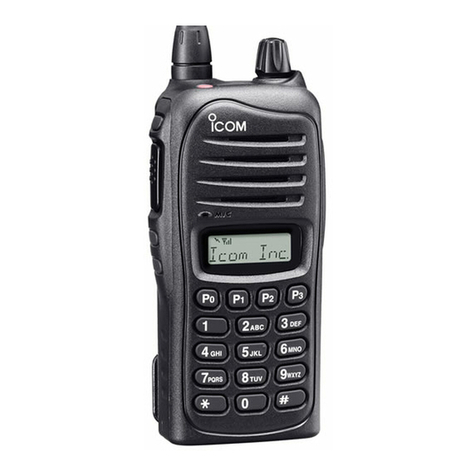
Icom
Icom IC-F3021T/S User manual

Icom
Icom IC-756PROIII User manual
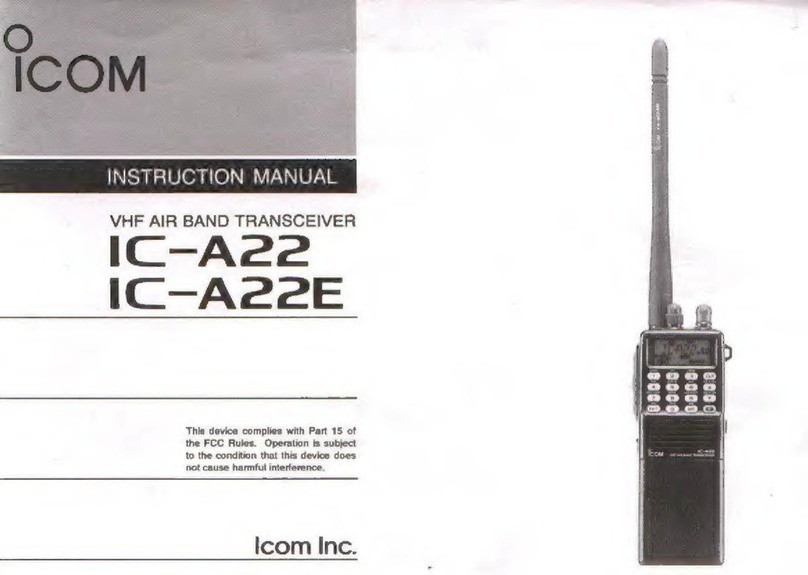
Icom
Icom IC-A22 User manual

Icom
Icom IC-M710RT User manual
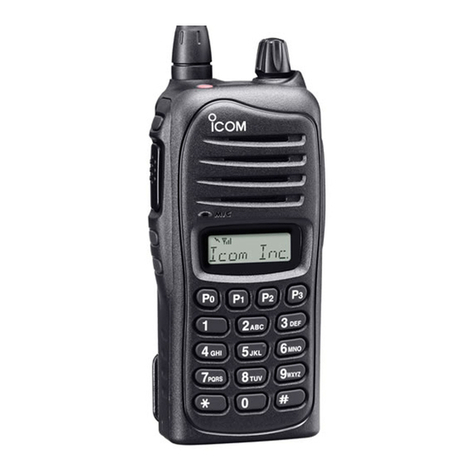
Icom
Icom IC-F3023T/S User manual
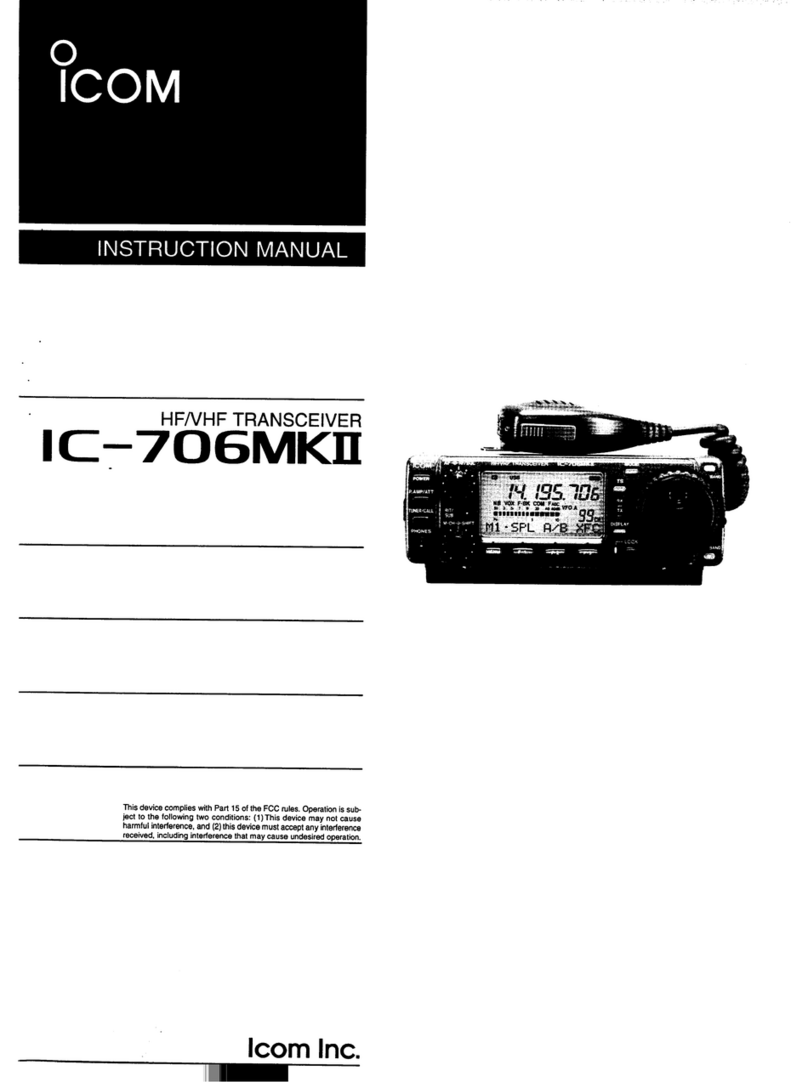
Icom
Icom IC-706MKII User manual
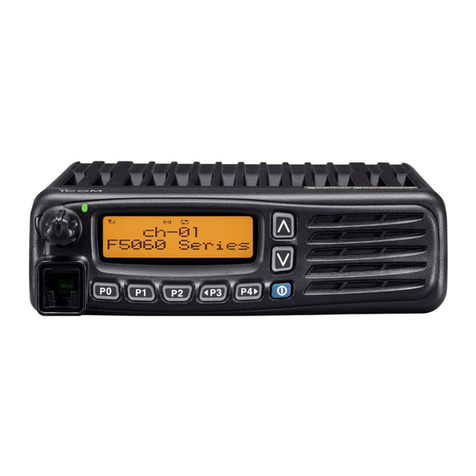
Icom
Icom IC-F6061 User manual
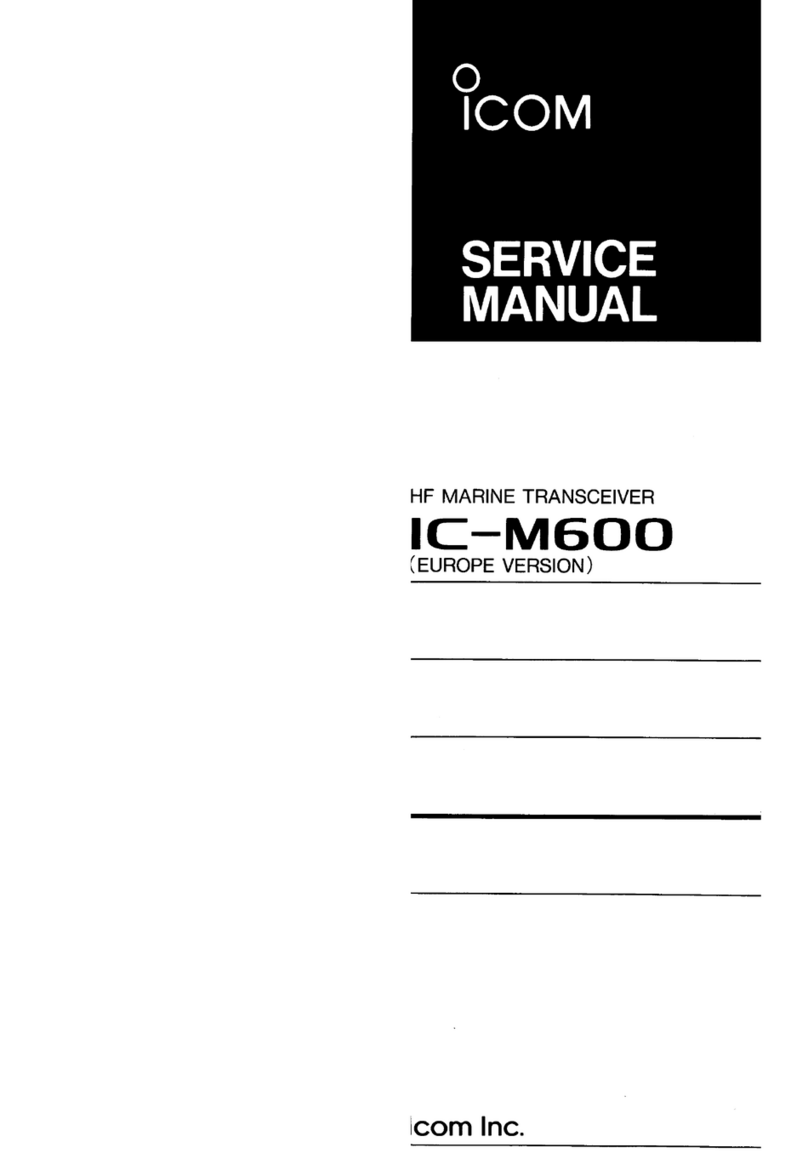
Icom
Icom IC-M600 User manual
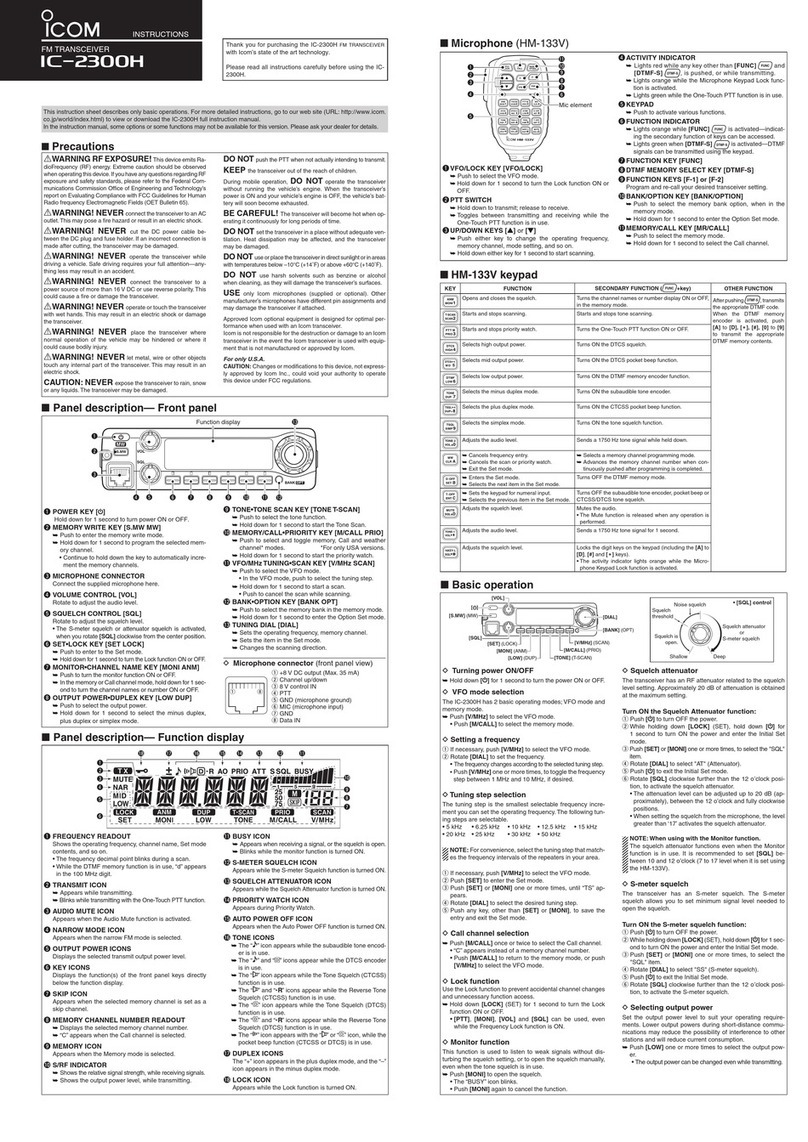
Icom
Icom IC-2300H User manual
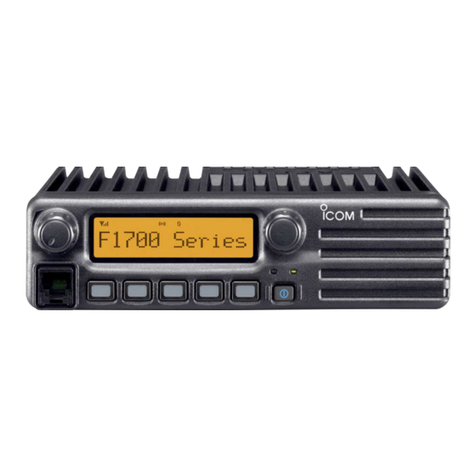
Icom
Icom IC-F1821D User manual
